PinotFile: 9.40 April 17, 2014
|
Winemaker & Winegrower Ted Lemon Celebrates 20 Years of Littorai, 30 Years of Winemaking
true littoral zone of the continent, hence this is where we source our grapes. Littorai searches to unearth the finest vineyards at the very boundary of where grapes can be successfully ripened.” Ted & Heidi Lemon, Mission Statement 1993 On March 3, 2014, a very special occasion was marked at Jardiniere Restaurant in San Francisco celebrating the 20 year anniversary of Littorai Wines and 30 years of winemaking for Ted Lemon. During this tasting, Ted shared 34 wines from not only 20 years of Littorai, but his journey as a winemaker over the last 30 years, beginning in Burgundy. Ted and Heidi opened a stunning lineup of wines from their personal cellar. This report will detail my impressions of that tasting.
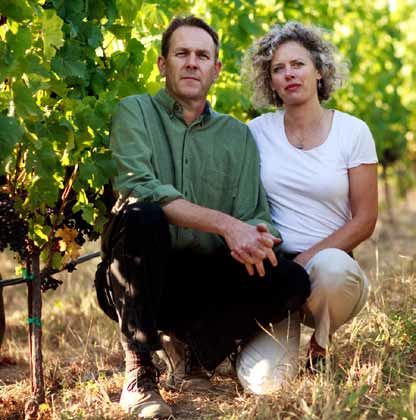 Ted Lemon has received well-deserved high accolades for his winemaking prowess through the years and I have written extensively in his praise. The first winemaker interview I ever did for Grape Radio was at Ted’s farm in the Sebastopol Hills back in 2007: www.graperadio.com/archives/2007/07/30/. His unique story is reviewed here. Born in Bedford, New York, Ted traces the origin of his interest in wine to a high school year in which he studied abroad in Burgundy. Later he attended Brown University where he majored in French literature. In his junior year of college, he spent six months at the Université de Dijon where he took a wine appreciation class from the director of Burgundy’s tourism office. The director was so impressed with the twenty-year-old Lemon, he offered him a job if he ever decided to take up winemaking. After graduating from Brown University, Ted was awarded a Samuel T. Arnold Fellowship and returned to France in the fall of 1980 to study viticulture and enology. He obtained his Enology degree from the Université de Dijon in 1981 and worked at many prestigious estates in Burgundy including Domaine Georges Roumier, Domaine Bruno Clair, Domaine De Villaine, and Domaine Dujac. Ted returned to the United States when his funds ran out and apprenticed with Josh Jensen at Calera Wine Company in Hollister, California. Late in 1982, while working at Calera, Ted was surprised by a call from Jacques Seysses of Domaine Dujac, who asked him, “How would you like to make Meursault?” At Domaine Guy Roulot in Meursault, one of the owners of one of the oldest and most traditional wineries in Burgundy, Guy Roulot, had died and his family was searching for another winemaker. Guy’s son, Jean-Marc had not chosen to follow in his father’s footsteps. The Roulot family had sought the advice of Jacques Seysses who was said to remark to Madame Roulot, “Of all the apprentices I’ve had, and I’ve had many, none has been as bright and capable as Ted Lemon. He has so many fine qualities, but there are two problems: he is twenty-five years old and he is American.” After consulting with Aubert de Villaine and others, Madame Roulot offered to make Ted the first American winemaker and vineyard manager at a major domaine in Burgundy’s history. The photo below shows a young Lemon with Meursault vigneron Marcel Fichet at Domaine Guy Roulot where Ted remained until 1984.
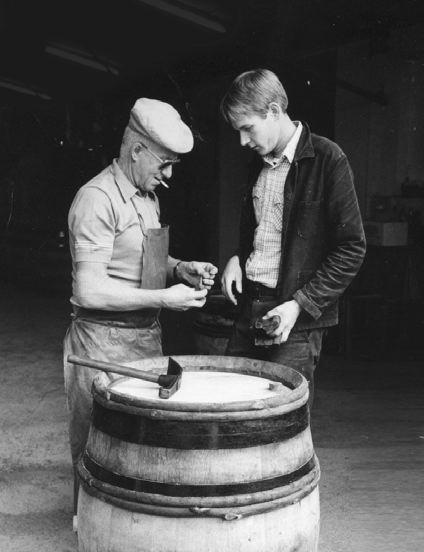 Upon returning to the United States, Ted was hired by a French family that owned a vineyard on Howell Mountain above the Napa Valley. Ted became the founding vineyard manager and winemaker, and oversaw the building of a new winery. The owners of Chateau Woltner planned to produce a French-style Chardonnay and Ted’s wines quickly attracted the attention of American wine connoisseurs. The wines were made in a non-malolactic style and as a result were high in acidity. Unlike high acid Chardonnays of Chablis, for example, the Chateau Woltner Chardonnays never did shed their acidity with age. Examples of these wines were not included in the tasting but were available for those interested after the tasting. With his winemaking and winegrowing skills assured, Ted and his spouse Heidi founded Littorai Wines in 1993. The name, Littorai (lit’tor-i) is a pleural derivative of the Latin word littor, which means the “coasts.” Ted and Heidi had spent a summer driving up and down the coasts of California and the Willamette Valley of Oregon to taste local wines and learn the terroir and history of neighborhood vineyards. He believed the finest Pinot Noir and Chardonnay were grown along the true littoral (coastal) zone of the continent, and became convinced that the geology and mesoclimates of the extreme portion of the continent north of San Francisco were diverse enough to create a series of unique terroirs. Ted settled on sourcing his grapes from vineyards in western Sonoma County and western Mendocino counties, finding those sites at the very boundary of where grapes could be successfully ripened. Ted’s years in France inspired him to base his winemaking on terroir-based postulates that specify that wine of a single place produced by a single estate is the greatest expression of winemaking. Pinot Noir and Chardonnay are wine grape varieties that are uniquely suited to this philosophy. According to Ted, “I believe soil is of major importance in a wine’s character. It’s clear there are tremendous differences between wines made from vineyards right next to each other even if they are vinified and treated exactly the same way. Here is a partial tribute to Ted Lemon’s individuality and accomplishments:
* Ted was the first and only American to become the head winemaker at a distinguished Burgundy domaine.
Ted’s winemaking approach emphasizes minimal intervention, gentle handling of fruit and wine, and long lees contact. Pumps and filtration are avoided. All Chardonnays are barrel fermented. Pinot Noir wines are all fermented in traditional open-top fermenters and at least some proportion of whole clusters are used, a key to their age ability. All wines undergo native yeast fermentation and complete malolactic fermentation, as long as nature does not dictate otherwise. Punch downs are done by hand. Usually one-third to one-half new French oak is used for aging the wines as an element of complexity. Elevage typically lasts 16-18 months. The goal is to avoid over ripe flavors and high alcohol levels, focusing on finesse, balance and length, and wines that can improve and blossom with cellaring. As Ted has remarked, “The key word here is patience; patient winemaking and patience from the consumer.” He is a patient winemaker who works with the juice at hand, an artist guided by his taste more than science, and one who avoids using new technology only for its own sake.
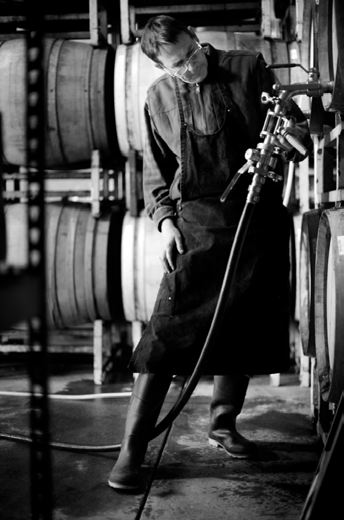 The old saw that California Pinot Noir can’t age has been put to rest years ago. This fallacy was propagated primarily because Americans have had little experience drinking aged California Pinot Noir. Current vintages of Pinot Noir are often intended to be consumed within a year or two of release and wine enthusiasts are encouraged to drink up before the next vintage arrives in the marketplace. Newly released Pinot Noir goes straight to restaurants where thirsty consumers quickly deplete them from wine lists. Have you seen any older vintages of American Pinot Noir on a restaurant wine list? Because Ted’s wines are focused on balance and harmony, they have the potential to evolve over time in bottle. With polished balance and proportion, his wines gain complexity as they age and are uniquely suited to the dinner table at any stage of their evolution. This was born out by the tasting of older vintages recently and by my many years of experience drinking Ted’s wines back to the 1994 vintage from multiple vineyard sources. Reviews of older vintages can be located in the PinotFile Winery Directory under Littorai. Littorai’s 10,000 case winery on Ted’s 30-acre biodynamic farm property in Sebastopol was completed in time for the 2008 harvest. The winery is a straw bale building built on two levels tucked into the side of a hill. The facility is designed for solar power (part of phase two construction) and to maximize energy efficiency. Winery water is reclaimed through an innovative constructed wetlands treatment system that allows water to be reused for vineyard and farm irrigation. Underground caves for barrel storage connected to the winery are also planned as part of phase two construction. The winery is a simple design yet functional, with no signage. Ted says, “This is not an indulgence.” Tastings by appointment are carried out informally on a table in the winery which has a noticeable absence of wine related schwag and paraphernalia for sale. I had no idea Ted had been crafting Rousanne, Barbara, Cabernet Franc and Cabernet Sauvignon for Reverie Winery since at least 1995 and and had made Cabernet Sauvignon for Howell Mountain Winery in the late 1990s. Until his own winery was completed in 2008, Ted had vinified his own Littorai wines as well on Howell Mountain at Black-Sears Winery. Ted’s introductory remarks to the tasting included the statement, “Age doesn’t matter; it’s whether the wine tastes good.” The blind tasting confirmed this, with most wines showing complexity, nuance and interest, and some remarkable longevity. By most tasters comments, it was clear that the wines tasted good.
The Tasting, March 3, 2014Upon Arrival 2012 Littorai Wines Anderson Valley Vin Gris of Pinot Noir 2010 Burn Cottage Vineyard Central Otago Pinot Noir Aromas of black cherry, exotic spices and forest floor. Darker stone and berry fruits are supported by firm, ripe tannins and bright acidity. Long, satisfying finish.
Flight One: Mixed Whites and Blacks 2012 Reverie Estate Bottled Diamond Mt. Rousanne Pale yellow and clear in the glass. Aromas of lemon, straw and wet stones. Delicate flavors of citrus, lemon-lime and slate with integrated acidity. 2010 Reverie Estate Bottled Diamond Mt. Rousanne Moderate yellow color and clear in the glass. Richer than the 2012 vintage on the palate with bright flavors of lemon, brioche, vanilla. Refreshing acidity. 2004 Reverie Estate Bottled Diamond Mt. Barbera Moderately dark reddish purple color in the glass. Aged bouquet with a hint of volatile acidity. Interesting and nuanced on the palate with flavors of dark stone fruits, dried cherry, green tea, and root vegetables wrapped in soft tannins. 1997 Reverie Estate Bottled Diamond Mt. Barbera Slight bricking at rim. Aged bouquet with a faint black cherry aroma and a slight medicinal note. Delicate, crisp flavors of cherry skin, ripe plum, tobacco and licorice. Modest tannic backbone, bright acidity and a long finish. 2002 Reverie Estate Bottled Diamond Mt. Cabernet Franc Moderately dark reddish purple color in the glass. Aromas of peat, oak and black raspberry. Middleweight flavors of black fruits with mild fine-grain tannins. A beautifully aged seamless wine that is still alive and highly pleasurable. 2001 Reverie Estate Bottled Diamond Mt. Cabernet Franc Moderately dark purple color in the glass. Aromas of blackberry jam with a hint of black olive. Full-bodied with substantial tannins supporting an array of tasteful black fruits. 1998 Reverie Estate Bottled Diamond Mt. Cabernet Franc Dark purple color in the glass. Dried herbs and cigar are prominent on the nose. Quite herbal on the palate but very soft and pleasurable featuring blackberry and black plum fruits. An impressive aged wine.
Flight Two: Cabernet Sauvignon 1999 Howell Mt. Vineyards Howell Mt. Cabernet Sauvignon Dark purple color in the glass with slight bricking of the rim. Aromas of leaf, cigar, and crème de cassis. Luscious and juicy on the palate featuring bold yet refined flavors of black currant and black plum. Enjoyable harmony, yet finishes with a touch of heat. 1997 Howell Mt. Vineyards Howell Mt. Cabernet Sauvignon Dark mahogany color in the glass with slight browning of the rim. The nose lacks any recognizable fruit, showing only a bouquet of herbs and leaf. Retains more dark fruit on the palate accented with tobacco and herbal notes. Substantial fruit with gentle tannins. 2009 Reverie Estate Bottled Diamond Mt. Cabernet Sauvignon Very dark purple color in the glass. Gorgeous nose featuring vibrant aromas of blackberry, black plum, crème de cassis and spice. Intense, vivid and fresh with perfectly ripened boysenberry and blackberry fruits complimented by integrated tannins. The finish is generous and lengthy. Wow! 2005 Reverie Estate Bottled Diamond Mt. Cabernet Sauvignon Deep, dark reddish purple color in the glass. Some primary black fruit aromas combined with secondary scents of leather and herbs. Soft and fresh in the mouth with plenty of black cherry and blackberry flavor supported by sinewy tannins. Quite good. 1995 Reverie Estate Bottled Diamond Mt. Cabernet Sauvignon Dark brown color in the glass with a yellowing rim. This wine has very little fruit left, offering instead an array of mature aromas and flavors including dried herbs, brown spice, leather, green pepper and cigar box.
Flight Three: Whites 2003 Littorai Wines Thieriot Vineyard Sonoma Coast Chardonnay Light golden yellow color in the glass. Pleasing aromas of browned biscuit, lemon and herbs. Good fullness on the palate with delicious flavors of lemon curd, caramel, brioche and brown spice, carrying over to a surprisingly long finish. Terrific. 2002 Littorai Wines Thieriot Vineyard Sonoma Coast Chardonnay Light golden yellow color in the glass. The core of citrus fruit has faded on the nose. Mature flavors of burnt caramel, creme brulee, and spice. 2000 Littorai Wines Mays Canyon Russian River Valley Chardonnay Moderate golden yellow color in the glass. The nose is dominated by aromas of apple core, sulphur and chemical tones. Much better on the palate with mineral-driven flavors of baked apple, lemon and brown spices. 1999 Littorai Wines Charles Heintz Vineyard Sonoma Coast Chardonnay Light golden yellow color in the glass. Bouquet of pear and truffle. Demure flavors of grilled, smoky citrus fruits with a slight nutty, honeyed tone. Admirable balance. 1995 Littorai Wines Mays Canyon Russian River Valley Chardonnay Steely aromas of lemon-lime. Relatively rich flavors of lemon curd on toast, finishing with citrus-driven acidity. Quite enjoyable. 1995 Littorai Wines Occidental Sonoma Coast Chardonnay Steely aromas of lemon zest which are somewhat vibrant. Enjoyable flavors of lemon, pineapple, toast and brioche with integrated acidity. Still has life. 1983 Domaine Guy Roulot Meursault Charmes Moderately dark golden yellow color in the glass. Incredibly young for a 30 year-old wine. Shy aromas of slate, lemon and a hint of vanilla. Good fullness and richness on the palate with flavors of yellow peach and lemon tart, finishing with some persistence. 1983 Domaine Guy Roulot Meursault Perrieres Very similar to the Charmes but more austere fruit, more steely acidity, and more bite.
Flight Four: Pinot Noir 2006 Littorai Wines Thieriot Vineyard Sonoma Coast Pinot Noir Moderately light garnet color in the glass with a slight bricking of the rim. Crazy good nose with bright spiced cherry aroma. Soft and seamless on the palate with fresh cherry and baking spice flavors framed by gossamer tannins. Exceptional. 2005 Littorai Wines The Haven Vineyard Sonoma Coast Pinot NoirModerately light orangish purple color in the glass. Aromas of cherries and cocoa lead to a delicately flavored wine that is rather dilute on the mid palate and finish. A very feminine wine that seems to be fading. 2004 Littorai Wines Hirsch Vineyard Sonoma Coast Pinot Noir Moderate reddish purple color in the glass. A very generous wine with bright aromas of black cherries and brown sugar. Deep, dark cherry and black raspberry core with exceptionally high acidity. A masculine wine with appeal.
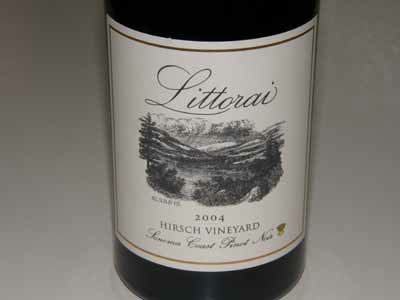 2003 Littorai Wines Hirsch Vineyard Sonoma Coast Pinot Noir Moderate reddish purple color in the glass with slight bricking of the rim. A more mature wine with aromas of dried cherry and chocolate and flavors of cherry skin, dried berries, and tea. Very smooth on the palate with soft, dry tannins. 2002 Littorai Wines One Acre Anderson Valley Pinot Noir Light reddish purple color in the glass with slight bricking of the rim. Very charming nose of cherry, spice and cinnamon toast. Elegant but flavorful with pleasing flavors of cranberry, red cherry, rhubarb and anise. Very soft tannins. Exceptional for a 12-year-old wine. 2002 Littorai Wines Savoy Vineyard Anderson Valley Pinot Noir Moderately light reddish purple color in the glass with slight orange bricking of the rim. The nose lacks primary fruit aromas and smells more of old book and medicine cabinet. The light red fruits are dominated by soft tannins that take over the finish. More interesting on a second pace but I needed more time to fully evaluate.
Flight Five: Pinot Noir 2000 Littorai Wines Thieriot Vineyard Sonoma Coast Pinot Noir Moderately dark reddish-purple color in the glass with an orange rim. Nicely perfumed with aromas of dried cherry, tea and toast. Delicate flavors of cranberry, cherry and orange with gossamer tannins. A great aged wine. One barrel produced. 1999 Littorai Wines Hirsch Vineyard Sonoma Coast Pinot Noir Magnum Peachy red color and slightly cloudy in the glass. Shy, but pleasing aromas of dried cherry and cranberry with a hint of oak. Yummy, delicate flavors of cherry and cranberry with bright acidity in the background and no detectable tannins. Delightful aged wine. 1997 Littorai Wines Savoy Vineyard Anderson Valley Pinot Noir Orange red color in the glass. Shy nose with very little fruit. Soft and refined on the palate, with flavors of cooked cherry, orange peel, and cocoa. Retains some firm tannin. 1994 Littorai One Acre Anderson Valley Pinot Noir Magnum Moderately light reddish purple color in the glass with an orange rim. Lovely, demure aromas of spiced cherry. Very smooth in the mouth with melted tannins and delicate flavors of cherry, baking spice and brewed tea. Wow! 1994 Archery Summit Red Hills Vineyard Willamette Valley Pinot Noir Light reddish purple color in the glass. Appealing aromas of maraschino cherry and spice. Very light and feminine but retains some structure behind the elegant cherry core. A bit of alcohol peaks out on the finish. Vinified at Pine Ridge Winery in California. 1980 Domaine Dujac Clos Saint Denis Magnum 100% whole cluster. Brown red color in the glass with a yellow rim. Interesting nose with secondary bouquet of molasses, cherry reduction sauce and leather. On the down slope with fading red stone fruits, yet retaining a notable tannic backbone.
Other Wines Tasted at the End 2003 Littorai Wines Thieriot Vineyard Sonoma Coast Chardonnay A remarkable wine that has a woody, straw, vinous, aged character that astounds. Similar to a Meursault. 2004 Littorai Wines Summa Vineyard Sonoma Coast Pinot Noir Still fresh and lively with a full-bodied compliment of sappy, dark red fruits underlain with a savory mushroom, redwood forest riff. Full of life.
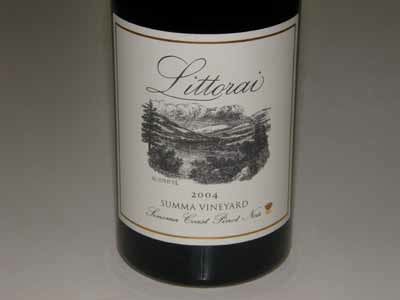
Additional Aged Littorai Wines Tasted RecentlyThe 2003 vintage was very generous and the wines had the most fruit remaining. The 2004 vintage was more defined by acidity. I do not feel anything is to be gained by aging the wines much longer, but none of the wines tasted were on the downslope.
2003 Littorai Mays Canyon Russian River Valley Chardonnay 13.8% alc.. · Moderate golden yellow color and clear in the glass. Enticing aromas of pear, honey, bees wax and sawdust lead to a slightly creamy palate featuring flavors of poached pear, golden apple, lemon curd, burnt caramel and roasted nuts. Some finishing power and impeccable balance. Score: 91
2003 Littorai Charles Heintz Vineyard Sonoma Coast Chardonnay 14.4% alc.. · Moderate golden yellow color and clear in the glass. Aged aromas of stainless steel and toasted brioche. Less vibrant and fruity with more oak sheen. Flavors of pear grilled peach, vanilla cream and toasty oak. Slightly creamy, with a bit of heat on the finish. Score: 89
2004 Littorai Thieriot Vineyard Sonoma Coast Chardonnay 14.2% alc.. · Moderately dark golden yellow color with a very slight orange cast in the glass. The aromas of honey, caramel, leather shoe and floral perfume were quite inviting. Complex flavor profile featuring pear, yellow peach, apricot, lemon pie and roasted nuts. Still plenty of fruit at play with vibrant acidity on a refreshing finish. Score: 93

2004 Littorai Charles Heintz Vineyard Sonoma Coast Chardonnay 14.2% alc.. · Strong aroma of burnt match (sulfur) upon opening that improves with air. Shy notes of lemon and hazelnut. More enjoyable on the palate with flavors of lemon and toasty oak, finishing with a vibrant lemon flourish and good acidity. Score: 88
2005 Littorai Mays Canyon Russian River Valley Chardonnay 13.9% alc.. · Lightest golden yellow color in the glass of the wines tasted here. Aromas of yellow peach and vanilla wafer. Pleasing flavors of lemon, yellow peach and almond. Soft in the mouth with bright backing acidity and a shallow finish. Score: 89
2001 Littorai Savoy Vineyard Anderson Valley Pinot Noir 14.2% alc.. · Dark reddish purple color in the glass with slight yellowing of the rim. Complex nose with scents of marzipan, black licorice, brown butter and caramel. Mid to full bodied flavors of black cherry, sassafras, brown spices and dark chocolate. A beautifully aged Pinot Noir with fully integrated tannins. A touch of heat shows up on the finish. Score: 90
2003 Littorai Sonoma Coast Pinot Noir 14.3% alc.. · Moderate reddish purple color in the glass. The nose opens beautifully over time in the glass revealing aromas of wild berry jam, strawberry, rose hips tea, leather, earth and slight oak. Still fresh, with deep berry and black cherry flavor. The fruit is on the riper side with noticeable length and persistence. The suede-like tannins make for enjoyable drinking. Remarkable vitality for an 11-year-old California AVA Pinot Noir. Score: 89
2003 Littorai Mays Canyon Russian River Valley Pinot Noir 14.6% alc.. · Dark reddish purple color in the glass. Secondary aromas of black licorice, black tea leaves, menthol and vanilla. Rustic, with slightly roasted fruit flavors of black cherry, black plum and blackberry. Full-bodied with muscular tannins and a big, fruity finish. A bad boy that is not a typical Littorai wine in this vintage. Score: 86
2003 Littorai Thieriot Vineyard Sonoma Coast Pinot Noir 14.6% alc.. · Dark reddish purple color in the glass. Aromas of beet root, sassafras, hazelnut, vanilla and a bit of funk. Well-endowed with luscious dark berry fruit, with added flavors of prune, mushroom and truffle. Has the firm tannins to support the big fruit, but lacks vitality. Score: 88
2004 Littorai Sonoma Coast Pinot Noir 14.3% alc.. · Moderate reddish-purple color in the glass. Nicely perfumed with aromas of dark red cherry and blackberry jam. More austere than the 2003 version, with more savory notes of mushroom, herbs and old wood complimenting the cherry fruit core. Bright and lively with some finishing interest. Score: 89
2004 Littorai Mays Canyon Russian River Valley Pinot Noir 14.2% alc.. · Moderate reddish purple hue in the glass. Interesting aromas of herb-kissed black cherries and eucalyptus. The luscious dark cherry core is alive and flavorful. Still sporting some firm, non-astringent tannins balanced with bright acidity. Quite enjoyable with the black cherry fruit returning in waves on the persistent finish. Score: 91
2004 Littorai Hirsch Vineyard Sonoma Coast Pinot Noir 14.3% alc.. · Moderately dark reddish purple color in the glass. Demure aromas of fresh black raspberry preserves and a hint of spice. Delicious, mid weight flavors of black raspberry, black cherry and cola which attack the mid palate with a vengeance, coating the mouth, and finishing with amazing juiciness, length and intensity. Great now, but would have been an exceptional wine in its prime a few years ago. This was a better bottle than tasted at the Littorai Tasting on March 3, 2014. Score: 94
2004 Littorai The Haven Vineyard Sonoma Coast Pinot Noir 14.4% alc.. · Moderate reddish purple color in the glass. Aromas of black fruits, mocha java and toasty oak. Flavors of blackberry, black currant, anise and seasoned oak are backed by firm tannins which lend a bit of astringency to the finish. A little too much oak and tannin at play. Score: 89
2004 Littorai Thieriot Vineyard Sonoma Coast Pinot Noir 14.4% alc.. · Medium reddish purple hue in the glass. The nose starts out smoky, becoming less so over time with appealing ancillary aromas of black cherry, black tea and dried herbs. Mid weight core of black cherry and blueberry fruits with an undertone of smoke, mushroom and oak. Seamless and charming, with suede tannins and a long, dry finish. More contribution from oak in this wine but in a good way. Score: 91
2004 Littorai Cerise Vineyard Anderson Valley Pinot Noir 13.7% alc.. · Dark reddish purple color in the glass. Shy, but pleasing aromas of blackberry, black cherry and sage. Middleweight flavors of dark cherries and berries with a touch of smoke, tar and black licorice. Silky, with fully integrated tannins and a very generous deep berry finish. Score: 92
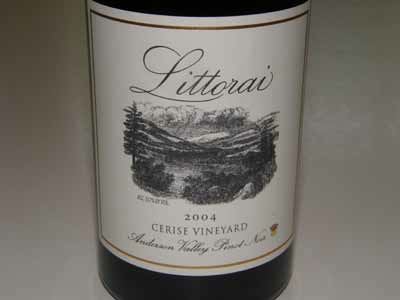
Clos de la TechSemiconductor pioneer and winemaker T.J. Rodgers (CEO of Cypress Semiconductor) and assistant winemaker, vineyard and winery manager Valeta Massey founded Clos de la Tech in 1994. Using the traditional winemaking process at Domaine de la Romanée Conti (DRC) as the baseline for making their wines and even packaging the wines in bottles that are remindful of those of DRC, the proprietors of Clos de la Tech have the stated goal “to make the New World’s best Pinot Noir and challenge the greatest Burgundies that have dominated Pinot Noir production since the 13th century.” Given that Rodgers has a reputation as a perfectionist and has the economic wherewithal to succeed, he may just accomplish his quest. The name, Clos de la Tech (Kl! deh la T"k), was inspired by the Burgundian word “Clos,” meaning “enclosed area.” All three of Clos de la Tech’s vineyards are enclosed by natural barriers such as cliffs and forests or by walls made of stone recovered from the vineyard. Since the vineyards lie in the Santa Cruz Mountains in the heart of Silicon Valley, a silicon chip adorns each bottle representing “Tech.” The 12 tiny chips that are placed in sealing wax on the shoulder crest of each bottle of 2009 reserve wine are fourth-generation PSoC 4 chips. PSoC chips were chosen to power the “click wheel” on the Apple iPad nano in 2005 and have powered the touch-screen interfaces of over one billion cell phones. The PSoC 4 chip is just one-tenth of the size of a finger nail, yet contains a 32-bit computer, 36 touch buttons, 2 amplifiers, an analogto- digital converter, 4 programmable logic blocks, 4 counter/timers, and 2 communcations interfaces. Each chip is priced at $1.00. PSoC 4 chips are the brains behind everything from espresso machines to toy helicopters to wearable body fitness monitors.
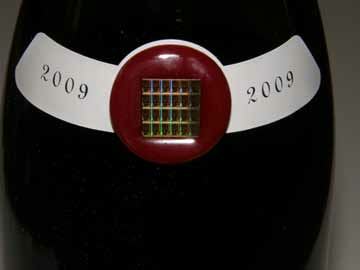 Rodgers has three close-planted vineyards all within 20 miles of each other: Domaine Docteur Rodgers (DDR), Domaine Valeta (DV) and Domaine Lois Louise (DLL). Domaine Docteur Rodgers is a one-acre, close-planted vineyard at 400 feet elevation adjacent Rodgers’ home in Woodside planted in 1994 to Dijon clones 113, 115 and 777 on Riparia Gloire, 420A and 101-14 rootstocks. Soil is loamy clay. The Pinot Noir from DDR is more fragrant and lighter in body than the winery’s mountain vineyards. The first Clos de la Tech Pinot Noir, 125 cases of Domaine du Docteur Rodgers Pinot Noir, was released from the 1996 vintage and priced at $101 per bottle, an unprecedented lofty amount for the time. The Domaine Valeta Vineyard (“Snow Vineyard”) is 4 acres planted on a 30-acre site perched on a peak at 2,350 feet looking down on Silicon Valley below. It is located on the first peak west of the famed Ridge Vineyard. This is a very cold site, even receiving snow in the winter, resulting in wines that have more body, tannin and color of any Clos de la Tech wine. The clones are 777, 115, 114 and 113 planted on Riperia Gloire, 3309 and 101-14 rootstocks. Soils are low fertility, well drained sandy loam. The first wine made from this vineyard was the 2002 vintage. Domaine Lois Louise, named after Rodgers’ mother, is an 80-acre ridge top vineyard at 1,700 feet, directly facing the Pacific Ocean within a 163-acre parcel in the hills above La Honda. This exposed site is vulnerable to a significant marine influence and is mostly above the fog line. This is probably the steepest vineyard in California, with a side slope of about 25º and an elevation climb of 966 feet. Rodgers had to design a special over-the-row tractor outfitted with cables to keep it from tipping over in this vineyard. Clones are 114, 115, 667, 777, and “828,” planted on Riperia Gloire, 3309 and 420 A rootstocks. The soils are clay loam on top of fractured rock. The yields here are the lowest of all Domaine de la Tech vineyards. The Domaine Lois Louise Vineyard (top photo) has three distinct terroirs: the Main Vineyard (DLL), Twisty Ridge (at the top of DLL pointing directly to the Pacific Ocean; so narrow it must be farmed by hand; seen in the bottom photo), and Cote Sud (south-facing slope). The wines produced from each part of the vineyard are distinct: the Twisty Ridge Pinot Noir is the biggest and darkest fruited with notable tannins, the DLL Cote Sud is lighter in body and is the most aromatic with a signature citrus aroma, and the DLL wine is similar to Cote Sud but without the citrus nuance on the nose. The first wine produced from this vineyard was from the 2004 vintage.
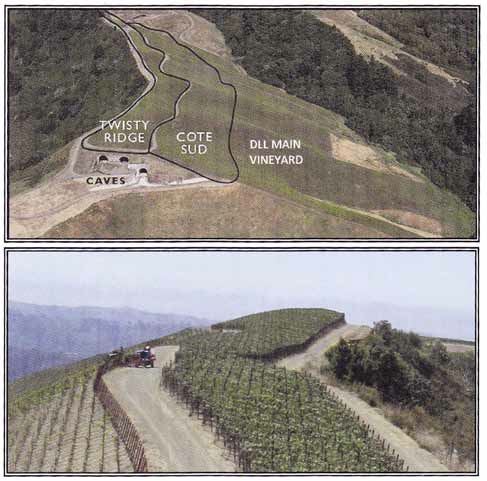 Vineyard practices include cluster thinning to reduce the number of seeds per grape and lower yields, concentrated plantings, and tipping (the tendril and top two small leaves on each cane are manually pinched off after 10% of grape flowers have bloomed, causing the vine to send a spurt of carbohydrate energy into the flowering grape clusters). Biodynamic viticulture is being instituted as well. The gravity-flow winery, tucked into a hillside on the Domaine Lois Louise property, is a technological marvel, and includes a cave for crush and fermentation, another for barrel aging, and a third for bottling and case storage. The winery is designed for 10,000 case production, although currently about 2,000 cases of Pinot Noir are vinified annually. Photos of the entrance to the winery and the interior of the winery below.
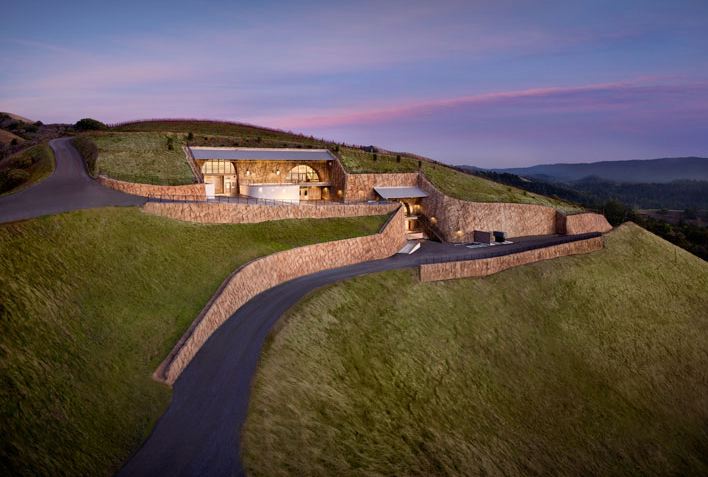
 The winemaking regimen is very traditional with rigorous sorting, whole cluster fermentations, native fermentations, and foot crushing. Temperature-controlled fermentation tanks are supported by utility stations and are uniquely designed to allow pressing in the fermentation tank. There are no pumps in the winery and the wines are never filtered. Wines are barrel aged for 18 months in 70% new three-year air-dried Francois Frères barrels and aged in bottle for at least two years. Clos de la Tech wines are sold almost entirely through a mailing list. A tasting room is located in the Half Moon Bay Cheese Co. where the tasting bar offers many other wines as well. Visit the website at www.closdelatech.com for more information. The winery is not open to the public. The five 2009 Clos de la Tech Pinot Noirs are reviewed below (current releases). All the wines have significant depth of color and extraction. The alcohols say 14.1% on the labels but from the size of the legs in the glass, the alcohols are most probably higher. The tannins are daunting on several of the wines due to the whole cluster ferments, so the wines need decanting or preferably several years in bottle for most enjoyment.
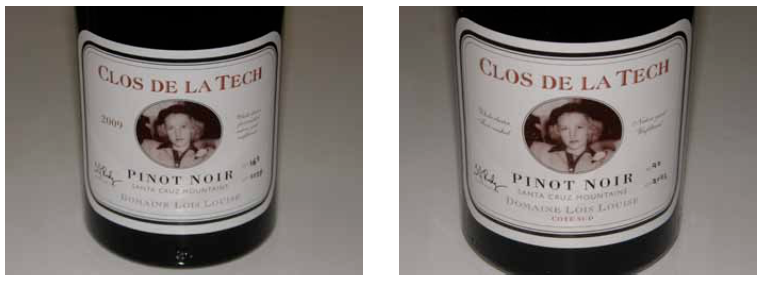

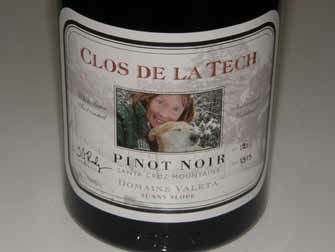
2009 Clos de la Tech Domaine Lois Louise Santa Cruz Mountains Pinot Noir 14.1% alc., 588 cases, $42. · Moderately dark reddish purple color in the glass. Typical whole cluster perfume of rose petals, exotic spice and black cherry. Richly endowed with generous flavors of black cherry, cassis, seasoned oak and spice. Sappy and sweet, with a noticeable mid palate attack, firm tannins and big fruit-driven finish. The least refined but the most hedonistic of the 2009 wines. Very approachable now but will improve in the cellar. Score: 89
2009 Clos de la Tech Domaine Lois Louise Cote Sud Santa Cruz Mountains Pinot Noir 14.1% alc., 170 cases, $62. · Dark reddish purple hue in the glass. The nose unfolds slowly to reveal aromas of red and black berries, tea leaves, oak, stem and salinity. Full-bodied with plenty of brutish tannins yet smooth and polished on the palate, filled with layers of black cherry, blackberry, dark chocolate and earthy flavors. Very subtle green note in the background. The tannins arrive with a rush on the long finish. When tasted the following day from a previously opened and re-corked bottle, the aromas of black currant, spice, wood pile and salty ocean air were more apparent. This wine needs cellaring for at least five years to soften and integrate the tannins and flavors. Score: 90
2009 Clos de la Tech Domaine Lois Louise Twisty Ridge Santa Cruz Mountains Pinot Noir 14.1% alc., 132 cases, $82. · Dark reddish purple color in the glass. Appealing aromas of cherry jubilee, briar, stem, oak and slate. Similar flavor profile as the Cote Sud but the fruit is more out front and vibrant with amazing persistence on the finish. Flavors of black fruits, cassis, spice, dark chocolate are supported by healthy, polished tannins. When tasted the following day from a previously opened and re-corked bottle, the tannins had softened and the mouthfeel was more velvety. Again, this wine should be cellared for at least five years for full enjoyment. Score: 93
2009 Clos de la Tech Domaine Du Docteur Rodgers Santa Cruz Mountains Pinot Noir 14.1% alc., 89 cases, $102. · Moderately dark reddish purple color in the glass. The nose blossoms over time in the glass to reveal bright aromas of black cherry, cassis and spice with complimentary notes of oakdriven vanillin and nuts. Very ingratiating. Delicious core of dark red cherries, strawberry, blackberry, vanillin, sassafras and earth. More charm at this early stage with notable but more modest tannins and slightly more acidity. Very juicy on the palate with a satisfying finish. Still great from a previously opened and re-corked bottle the following day with a vast compliment of aromas including black cherry, rose petal, marzipan and vanillin. Surely will benefit from further aging, but hard to resist now. Score: 94
2009 Clos de la Tech Domaine Valeta Sunny Slope Santa Cruz Mountains Pinot Noir 14.1% alc., 126 cases, $62. · Moderate reddish purple color in the glass with the reddest hue in the lineup. Enticing aromas of dark cherries, baking spices, mushrooms and toasty oak. This wine is not as imposing as other wines in the lineup currently and exhibits impeccable balance. It is the most enjoyable wine now. Delicious mid weight flavors of cherry, strawberry, raspberry and mocha with moderate backing tannins and a wonderful peacock tail finish. The oak is nicely integrated and the mouth feel is very suave. When tasted the following day from a previously opened and re-corked bottle, the wine was still seductive. Score: 94
Ceja Vineyards: Inspiring Preserverance Leads to SuccessThe Carneros region is steeped in Mexican history. Mariano Guadalupe Vallejo, the Military Commander and Director of Colonization of the Northern Frontier of California arrived in this region in 1834 to assume control of Mission San Francisco Solano in Sonoma and distribute the mission lands. Thousands of acres of land were supposed to be given those of naturalized Mexican citizenship who promised to develop the land. In truth, the land grants were awarded almost exclusively to Vallejo’s relatives and friends. The Carneros region lies within the original boundaries of four of these land grants: Rincon de los Carneros, Entre Napa, Huichica and Petaluma. The land grants were soon subdivided and sold to American, German, French and Irish settlers in the 1840s. Discontent with the Mexican government began to grow and in 1846, American frontier settlers overthrew Vallejo’s forces in the Bear Flag Revolt. As a result, California existed as a republic for a month before being incorporated into the United States. Approximately 100 years later, in 1942, the guest worker program was initiated and Mexican immigrants came to the Carneros region, becoming the backbone of the wine industry by providing a majority of the field labor. Many braceros toiled long hours as field hands in the vineyards earning limited wages and receiving little or no benefits. Over time, the value of migrant Mexican workers became recognized, leading to a dedicated effort to provide proper health care and living facilities as well as advancement opportunities. Despite considerable hardship, there were a number of migrant workers who had the skills and passion to succeed in the wine industry and they seized the opportunity. Ceja (“Say-ha”) Vineyards personifies one of the success stories that unfolded in the Carneros region. I spent a few hours with Amelia Morán Ceja recently who hosted me at her beautiful visitor center in Napa Carneros on Las Amigas Road. She is the much-loved public face of Ceja Vineyards, the marketing talent behind the label, and the first Mexican-American women to open a commercial vineyard and run a winery. She detailed her remarkable family history.
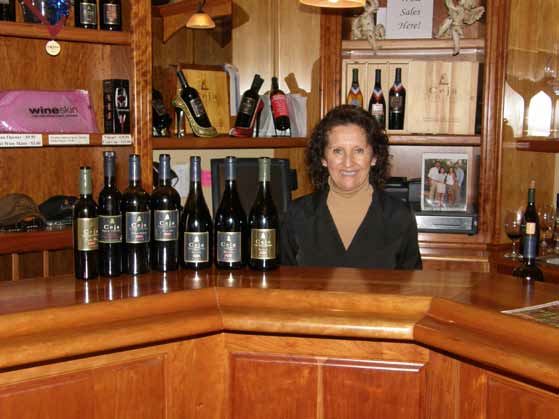 Pablo Ceja, his wife Jaunita, and their six children immigrated to the United States from Jalisco in the Central Highlands of Mexico in 1967 as part of the bracero work program. They were part of the first wave of Mexicans to bring their entire families to the United States. Usually the men braceros came alone and returned home for three months during the winter. To bring their family to the United States, they had to provide evidence that they could support them. The Ceja family initially settled in St. Helena in the Napa and later moved to Carneros, where the family grew to ten children, with all of them working together in the vineyards. When Amelia Morán Fuentes was 12 years old, she immigrated to the Napa Valley to join her father, a vineyard worker. She remembers clearly what an eye-opening culture shock she experienced, having grown up in a village of 50 to 75 people. There were few Mexicans in Napa then; today they comprise over 35% of the population. Several years later, she would meet Pedro, one of Pablo’s sons, while the two were picking Merlot at the Ta Kalon Vineyard in Napa. They had dreams of a college education and owning land upon which they could grow their own grapes. Amelia and Pedro married after college while they were in their early 20’s. Pooling both of their family’s resources, they bought 15 acres in Carneros on Las Amigas Road in 1983, planting 13 acres of Pinot Noir there in 1986. Amelia and Pedro founded Ceja Vineyards in 1999 along with Amelia’s brother-in-law Armando Ceja and his spouse Martha. Armando is a University of California at Davis trained winemaker and viticulturist who directs the viticulture and winemaking program at Ceja Vineyards and has his own vineyard management company, Vina Del Sol (Vines of the Sun). Ceja Vineyards now farms 199 acres of vineyards in Napa and Sonoma counties including vineyards on Las Amigas Road in Napa Carneros (Chardonnay, Pinot Noir), Arnold Drive (Chardonnay, Merlot) and Dale Avenue (Viña del Sol Vineyard; Pinot Noir) in Sonoma Carneros, Adobe Road (Chardonnay, Pinot Noir, Sauvignon Blanc, Syrah, Arneis) in Petaluma, and La Loma Vineyard (Cabernet Sauvignon) in Napa. The business is so successful that they plan to double production over the next five years with the aim of producing all wines from estate grapes. Beginning in the spring of 2014, construction will begin on a 23,000-case winery on the Ceja Vineyards Napa Carneros property. The winery will feature a mission-style design in homage to the missionaries who introduced wine to this region with authentic Mexican embellishments added to the exterior. The aerial view of the Las Amigas Road property:
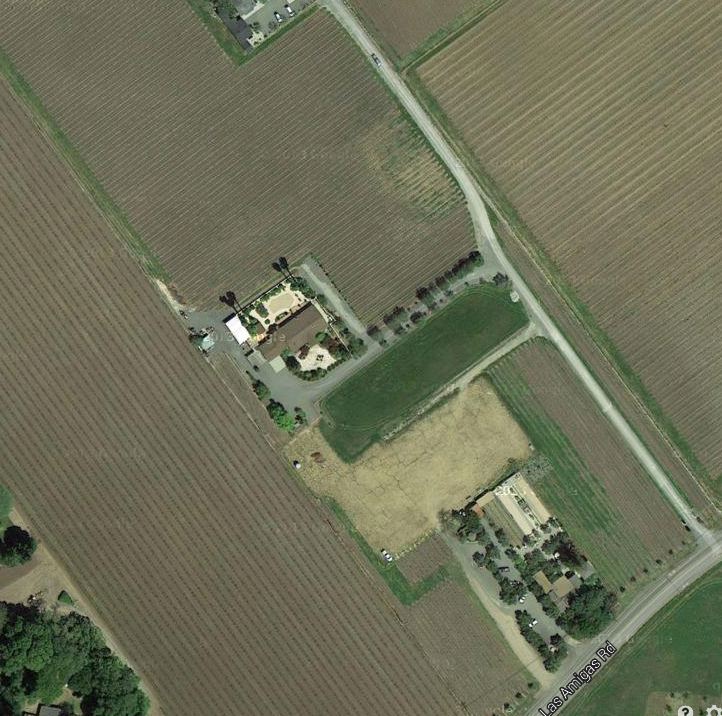 Amelia is a remarkable women who not only is involved in the winemaking, the marketing of the Ceja brand, and the management of the winery, she is an accomplished chef and gardener. Growing up in a small Mexican village, she developed a passion for cooking for the laborers and by age 8 years was regularly helping her mother, the matriarch of the village, in the kitchen and harvesting fresh produce for each meal. She has never lost that passion and inside the new winery will be a large commercial kitchen for weekly cooking classes and special wine and food pairings. Amelia obtained certification as a Master Gardener at University of California at Davis and plans to have gardens surrounding the winery so that fresh produce can be used in the classroom recipes. Amelia and her daughter Dalia have been creating how-to cooking videos for years. These videos, which feature wine and food pairings, are available for viewing at www.cejavineyards.com under “Recipes.” The issue of Sunset Magazine (October 2013) that featured Amelia and her recipes was the magazine’s biggest selling issue The winery’s logo features a bell with the Latin inscription, vinum (wine), cantus (song), and amor (love). It was Pedro who decided to use a town bell as the trademark for their brand since it fit perfectly with their idea of a mission-style winery.
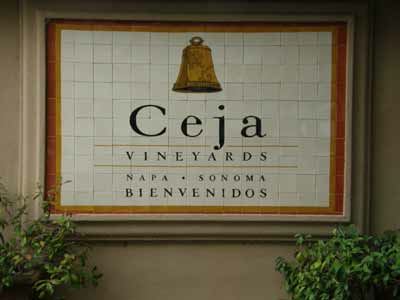
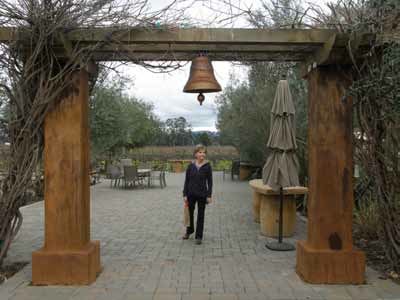 Ceja Vineyards produces multiple varietals including Pinot Noir, Cabernet Sauvignon, Merlot, Syrah, a Proprietary Red Blend, Chardonnay, Sauvignon Blanc, sparkling and dessert Wine. A wine tasting salon, lounge and art gallery is located in downtown Napa at 1248 First Street. All the wines tasted with Amelia and those later sampled at home were of high quality and are easy to recommend. Amelia remarked, "We are a minority owned and certified winery, but our reputation is built on producing good wines." The balance is spot on in these wines. The Pinot Noirs are sourced from the estate Viña del Sol Vineyard located 5 miles west of the winery’s Las Amigas Road hacienda and vineyard. The wines are a field blend of 50% Dijon and 50% Pommard clones. 100% de-stemmed.
2010 Ceja Napa Valley Carneros Estate Chardonnay 13.6% alc., pH 3.38, 1,000 cases, $34. Viña del Sol and Las Amigas Road vineyards. Harvest Brix 24.3º. 100% barrel fermentation with no MLF, aged sur lie 11 months in French oak barrels. · Moderate golden yellow color and clear in the glass. Very aromatic and complex, with scents of lemon pie filling, golden apple, banana fritter, pineapple, nutty oak and ocean air. A very well composed wine with generous flavors of citrus, tropical fruits and pear, bright acidity, a polished and slightly creamy mouthfeel, and surprising length of finish for a Chardonnay. Score: 90
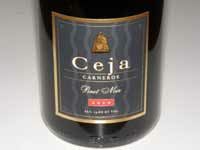 2010 Ceja Carneros Estate Pinot Noir 13.8% alc., 1,000 cases, $40. Ready to release. Viña del Sol Vineyard. 100% de-stemmed. Aged in 10% new and 90% neutral French oak barrels. · Moderately light reddish purple color in the glass. Lovely aromas of fresh cherry pie glaze and baking spices. Elegantly fashioned and very appealing, with bright flavors of red cherries, strawberries, spice and mocha carrying over on a long, juicy, memorable finish. Very approachable with soft tannins, bright acidity and admirable harmony. Score: 90
2009 Ceja Sonoma Carneros Estate Pinot Noir 13.7% alc., 1,000 cases, pH 3.48, $40. Viña del Sol and Dale Avenue vineyards. Brix at harvest 24.7º. Aged 20 months in French oak barrels. · Moderately light reddish purple color in the glass. Shy, but appealing aromas of black cherry, raspberry and toasty oak. More rich sap and structure than the 2010 Estate Pinot Noir, with a core of earth-kissed darker red and black stone and berry fruits accented by notes of tea and savory herbs. The oak is beautifully integrated, the wine is nicely balanced, and the finish has uncommon length. Recommended food match is pozole. Score: 90
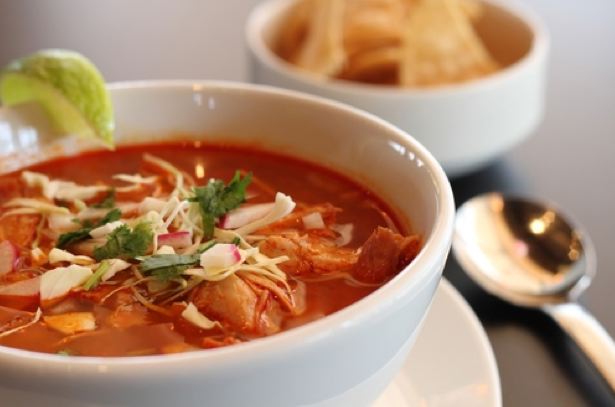
2009 Ceja Sonoma Coast Pinot Noir 13.8% alc., $50. Not released. Sourced from Adobe Vineyard located in the Petaluma Gap. Primarily Dijon clones. 100% de-stemmed. Aged 23 months in French oak barrels. · Medium reddish purple hue in the glass. A variety of aromas emerge over time including red stone fruits, plum, rose petal, dried herbs and smoky oak. Moderate in weight with flavors of black cherry, black raspberry, black tea and sassafras with complimentary oak and spice in the background. The tannins are suave and the finish has some generosity. Score: 89
2009 Ceja Vino de Casa Napa Valley Red Blend 13.6% alc., pH 3.53, 2,000 cases, $20. Viña del Sol Vineyard. Average Brix at harvest 24.1º. 60% Pinot Noir, 40% Syrah. Aged 23 months in French and American oak barrels. · A pleasant, easy-drinking wine with well-integrated tannins, a spark of acidity, dark fruits, mocha and peppery spice. A good food match would be chilaquilles. Score: 87

2008 Ceja Napa Valley Cabernet Sauvignon 13.9% alc., pH 3.48, 800 cases, $50. La Loma Vineyard located on the Silverado Trail. Harvest Grix 24.5º. Open top, small vat, cold soaked, extended maceration, gentle punch downs. Aged 34 months in French oak barrels. · Dark reddish purple color in the glass. A moderately rich, nicely aged wine with a slightly creamy core of black cherry, plum, cassis and blackberry flavors with modest complimentary tannins and a richly endowed finish. Very smooth in the mouth, displaying the impeccable balance typical of Ceja wines. Score: 91
2008 Ceja Napa Carneros Dulce Beso Dessert Wine 11.6% alc., pH 3.44, residual sugar 14.6, 600 cases, $40. Viña del Sol and Las Amigas Road vineyards. Harvest Brix 34.2º. Stainless steel fermented, no MLF, aged 14 months in French oak barrels. A botryitized wine composed of 94% Sauvignon Blanc and 6% Semillon. · Moderate golden yellow color in the glass. A thoroughly satisfying way to cap a meal. Complex aromas and flavors of coconut, pear, white peach, honey and roasted nuts with refreshing acidity and a persistent finish. A good food match is Mt. Tam cheese. Score: 89
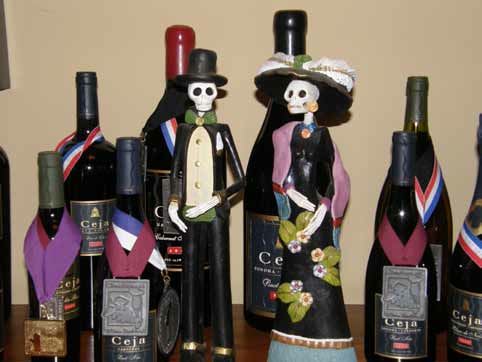 For more reading on Amelia: Rock and Vine: Next Generation Changemakers in America’s Wine Country (2013), Women of the Vine: Inside the World of Women Who Make, Taste and Enjoy Wine (2006), and Sunset Magazine (“Best Wines for Mexican Food, October 2013).
Newest Bacigalupi Wines Truly Honor a LegacyThe Bacigalupi family are Russian River Valley originals, with a history of farming on Westside Road dating back to 1956 when Charles and Helen Bacigalupi bought the 121-acre Goddard Ranch. Today, the Goddard Ranch has 120 vineyard acres and is the oldest ranch that the Bacigalupis farm. This property contains the Chardonnay planted to an old Wente clone that was one of the main sources of the legendary 1973 Chateau Montelena Chardonnay that won the 1976 Paris Tasting as well as old Wente selection of Pinot Noir. Charles’ son, John, was raised on the Goddard Ranch and after a lifetime of winegrowing experience, teamed with his spouse, Pam Heck Bacigalupi, and fourth-generation nephew and winemaker, Tyler Heck, to found John Tyler wines. The Bacigalupi family’s third-generation twin sister daughters, Nicole and Katey, became the face of John Tyler Wines and were instrumental in the building of a stylish tasting room on Westside Road where the wines were featured.
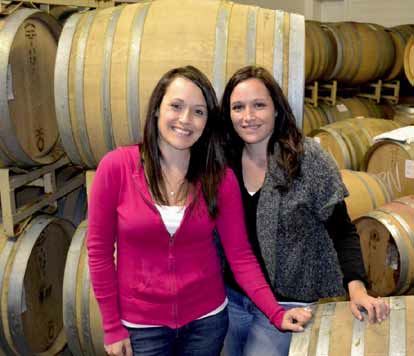 John Tyler Wines first produced a Pinot Noir from estate grapes in 2002, with Tyler Heck as the winemaker. The John Tyler Pinot Noirs have been a mix of Pommard clone and old Wente selection from the Bacigalupi’s Frost Ranch Vineyard. The wines were vinified with the structure to age, speaking more of savory notes than fruit, and possessing well-structured tannins that required time to soften and integrate. In 2013, the name of the winery began transitioning from John Tyler Wines to Bacigalupi Vineyards to honor the legacy of winegrowing of the Bacigalupi family. The first releases bearing the Bacigalupi label are from the 2011 vintage and are vinified by new consulting winemaker Ashley Hertzberg. She developed her winemaking skills working with noted winemakers Merry Edwards, Anthony Austin and Scott Covington, and later as a consulting winemaker for Saini Vineyards and Amista Vineyards. Along with the change in winemakers has come a stylistic change in the wines as well. They are now more gracious upon release, more approachable and enticing, yet still retain the potential for age worthiness. The Bacigalupi wines are available at the winery’s tasting room (photo below) located in Healdsburg on Westside Road and the online website store at www.johntylerwines.com. The Bacigalupi twins staff the tasting room and are delightful hosts. The Bacigalupi wines have a pedigree, a legacy and a family that embraces the consumer’s interest. All generations of the Bacigalupi family will be present at their 3rd Annual Vineyard Designate Tasting featuring the esteemed wineries and their wines from Bacigalupi Vineyard. For more information, visit www.bacigalupivineyards.com.
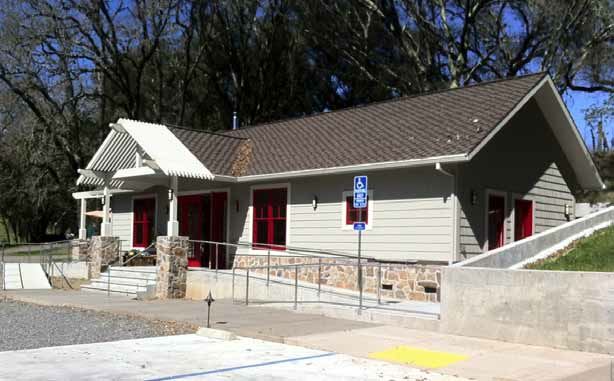
2012 Bacigalupi Russian River Valley Pinot Noir 14.5% alc., 300 cases, $65. 63% Wente and 37% Pommard clones. Brix at harvest 25.8º. 100% de-stemmed, whole berry fermentation. Inoculated with AMH yeast. Total cold soak and fermentation 19 days. Lees stirring weekly during malolactic fermentation and every other week thereafter. Aged 11 months in 42% new and 58% used French Francois Frères oak barrels. Unfined and unfiltered. · Moderately light reddish purple color in the glass. Bright aromas of Bing cherries, strawberries, blackberries, forest floor and complimentary oak. Plenty of nuance to discover in this wine which offers flavors of dark cherry, sassafras, anise, exotic cinnamon spice, herbs and cola. Refined, seamless and quite approachable with balanced tannins and acidity and a clean, pleasant cherry-driven finish. Even better the following day from a previously opened and re-corked bottle predictive of age ability. Awesome! Score: 94
2012 Bacigalupi Russian River Valley Chardonnay 14.1% alc., 179 cases, $56. The vines that produced this Chardonnay were grafted from the original vineyard that supplied grapes to the 1973 Chateau Montelena Chardonnay that won the coveted 1976 Paris Tasting. Brix at harvest 24º. Barrel fermented, 90% MLF, lees stirring every other week for 9 months, aged 11 months in 50% new Francois Frères medium toast French oak barrels. Unfined and unfiltered. · Moderate golden yellow color and clear in the glass. I couldn’t pull my nose away from the glass which offered aromas of pineapple, grilled lemon, white peach, and butterscotch. A seamless, relatively plush wine with just the right spark of acidity and contribution from oak. More minerality is evident on the palate which offers flavors of lemon, crème brûlée, and tropical fruits. A beautiful thing. Score: 93
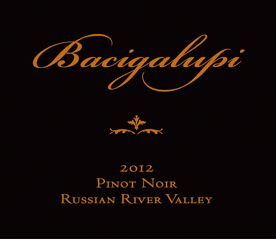
Adventures on the Pinot Trail: In Pursuit of Balance 2014In Pursuit of Balance (IPOB) is intended to bring together like-minded winegrowers, winemakers, sommeliers, retailers, journalists and consumers who believe in the potential of California to produce profound, balanced Pinot Noirs and Chardonnays. In the words of the founders, Rajat Parr and Jasmine Hirsch, “This isn’t a rebellion, but rather a gathering of believers. The event is meant to open a dialogue between producers and consumers about the nature of balanced wine.” Listen to Jasmine Hirsch talk about IPOB in a recent interview I conducted before this event: http://www.princeofpinot.com/download/audio/IPOB_Jasmine%20Hirsch.mp3.
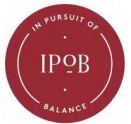 The most recent In Pursuit of Balance event was held at Bluxome Street Winery in San Francisco on March 10, 2014. 400 people of the trade and media, including many well-known wine writers, sommeliers and winegrowers attended the morning seminars and early afternoon tastings, and over 450 consumers converged on the site for the early evening tastings provided by 31 wineries. The energy in the tasting venue was high and the quality of the wines were something to be thankful for. Video of the seminars is available for viewing at www.inpursuitofbalance.com. The participating wineries, all from California, included: Anthill Farms Winery, Bluxome Street Winery, Calera Wine Company, Ceritas, Chanin Wine Company, Cobb Wines, Copain Wines, Domaine de la Côte, Drew Family Cellars, Failla, Flowers Vineyard & Winery, Hanzell, Hirsch Vineyards, Knez Winery, Kutch Wines, LaRue Wines, LIOCO Wine Company, Liquid Farm, Littorai, Matthiasson, Mount Eden Vineyards, Native 9, The Ojai Vineyard, Peay Vineyards, Red Car Wine, Sandhi Wines, Soliste, Twomey, Tyler Winery, Varner, and Wind Gap.
Seminar 1: Vine AgeModerator: Alder Yarrow, Vinography
Panelists: Michael McNeill, winemaker, Hanzell,
There is no clear, widely accepted objective definition of an old vine. Wikipedia states, “In a place where wine production is longstanding, it often means a wine whose vines are 30 to 40 years old.” Some winemakers consider these to be “mature” vines only, and insist that the term “old” vines be reserved for vines older than this. The term old vine is relative because in a newly established winegrowing region, 20 years might be considered old. The panelists discussed whether vine age makes a difference in the quality of wines and how vine age effects viticultural and winemaking decisions. There are a number of widely accepted dictums regarding old Pinot Noir vines that I have gathered from previous seminars and the wine literature. I have added in opinions expressed in this seminar.
* Vine age is difficult to taste in Pinot Noir as site often trumps vine age.
Summary: When the panel was asked whether old vines make better wine than young vines, Matthiasson said, “yes,” McNeill said, “yes,” Tolmach skirted the answer and said, “they can,” and Mahle said, “yes, some of the time.”
2011 Wind Gap James Berry Vineyard Paso Robles Chardonnay Harvest Brix Vines planted in 1981. Harvest Brix 21.2º, 12.5% alc.. No new oak. More aromatic than Woodruff with floral and citrus notes most prominent. More body also, with crisp, more intense lemon-lime flavor. 2012 Wind Gap Woodruff Vineyard Santa Cruz Mountains Chardonnay Vines planted in 1978. Harvest Brix 22.7º, 13.5% alc.. No new oak. Delicate aromas of lemon, pineapple, wet stones. Acid-driven with citrusimbued minerality. The differences between the Wind Gap wines are probably more related to site differences. No definite conclusion about old versus young vines can be determined since the plantings of the two wines are only three years apart. That said, both wines are from older vines and were superb. 2011 Matthiasson Michael Mara Sonoma Coast Chardonnay 5-year-old vines. Aromas of pear, butterscotch and caramel. More fruity than the Linda Vista with less nuance. 2011 Matthiasson Linda Vista Napa Valley Chardonnay 20-year-old vines. Rich lemony aromas. More acid driven and austere with more minerality and a slightly tart finish. The older vines produced a wine that was more lean and mineral driven with less flamboyant fruit on the nose and palate. 2012 Ojai Bien Nacido Vineyard Santa Maria Valley Pinot Noir Vines planted in 2002. Very aromatic showing rose petal, candied cherry, herbs, oak and spice. Generous, long finish. 2012 Ojai Bien Nacido Vineyard Santa Maria Valley Pinot Noir Vines planted in 1973. Less primary fruit but more secondary characters. More complex, more grainy tannins and a longer finish. Overall, a more interesting wine. A big difference here, with the older vine Pinot Noir showing much less primary fruit aromas and flavors and more interesting secondary savory notes. The highlight of this seminar were the three wines presented by winemaker Michael McNeill of Hanzell. These were remarkable old, older and very old vine Pinot Noir that were marvelously fresh and nuanced. 2012 Hanzell de Brye Vineyard East Slope Sonoma Valley Pinot Noir Vines planted in 1999. Aromas of earthy cherry. Silky on the palate with crisp cherry and cranberry flavors. Still tight, but enjoyable. 2012 Hanzell de Brye Vineyard Sonoma Valley Pinot Noir Vines planted in 1976. Very Burgundian with many secondary aromas and flavors including herbs, tea, leather and earth. The red fruits are shy but pleasing and the finishing is amazingly long. 2012 Hanzell Ambassador’s 1953 Vineyard Sonoma Valley Pinot Noir The shy nose offers inviting raspberry and spice aromas. Delicious, fresh fruit core with plenty of vigor. Seamless with a gorgeous finish.

Seminar 2: Defining Ripeness in Pinot NoirModerator: Dr. Jamie Goode, Wineanorak
Panelists: Justin Willett, owner and winemaker Tyler Winery
Benjamin Lewin MW has proclaimed, “If there’s one single issue that should be dominating discussion of wine today, it’s what we mean by ripeness.” In my mind, when people talk of ripeness, they are speaking about grape maturity. Jamie Goode, in his book, The Science of Wine (2005), clarifies this terminology. He states, “Two types of maturity are talked about in wine circles: sugar accumulation and phenolic (or physiological) maturity; the latter is also referred to as flavor maturity by some. Match the right grape variety to your vineyard climate, do your viticulture well, and you’ll reach the goal of perfect maturation: flavor maturity coinciding with a sugar level that will yield a wine of twelve to thirteen per cent alcohol. There is, however, a disconnection between the physiological processes (which govern the rate of sugar accumulation and loss of malic acid, which are dependent on climatic factors) and the color, aroma and tannin development (phenolic maturity), which is less dependent on climate. Grape phenolic maturity is independent of sugar levels. The result is that, in warmer climates (many New World wine regions), grapes only reach physiological maturity at sugar levels that are considerably higher than those in cooler regions.” Pearls from Seminar 2:
* Level of ripeness is important for the wine’s ability to reflect the site (terroir). If too ripe, generally beyond
14.5% alcohol, terroir can be obscured or undiscovered.
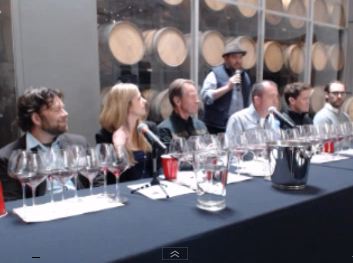 Wines Tasted at Seminar 2: 2011 Tyler Sanford & Benedict Sta. Rita Hills Pinot Noir 13.4% alc.. Aromas of cherries and herbs with flavors that echo the nose. Mid weight core with mild tannins and bright acidity. 2011 Tyler Bien Nacido Vineyard Old Vines Santa Maria Valley Pinot Noir 13.6% alc.. A completely different wine with aromas of oak and herbs, and flavors of earthy, herbal dark cherry. This wine is displays riper and more robust fruit, more power. The differences between these two wines are primarily site-driven, and not related to significant ripeness or chemistry differences. Both vineyards planted in early 1970s, unrooted. 2013 Calera Mills Vineyard Lot A Mt. Harlan Pinot Noir Barrel sample. First batch Picked at 22.9º Brix, 12.9% alc.. Deeply colored. Leaner, tighter and more primary than Lot B. 2013 Calera Mills Vineyard Lot B Mt. Harlan Pinot Noir Barrel sample. Picked at 24.2º Brix 18 days later, 13.8% alc.. Riper tasting fruit, more generous, and appealing. The Calera wines presented by Josh Jensen gave the best insight into differences in wines picked at two stages of ripeness. The second wine was picked 18 days later than the first wine, and practically everyone in attendance preferred the second (Lot B) wine. Both wines from unrooted vines planted in 1984 with same exposure, same plant material (Calera field selection). The wines will spend one more year in barrel. 2012 LaRue Rice-Spivak Vineyard Sonoma Coast Pinot Noir Barrel sample. 13.2% alc.. Very soft in the mouth with a fruity finish. Definitely more plush fruit than the 2010 wine veering toward dark red cherry. 2010 LaRue Sonoma Coast Pinot Noir 100% Rice-Spivak Vineyard. 12.6% alc.. Redder fruits (cherry, especially strawberry) with an herbal streak. A very pretty, delicate wine. The winemaker prefers to pick when flavors between strawberry and cherry, but this decision will vary with the vintage. 2007 Copain Kiser En Bas Anderson Valley Pinot Noir 13.5% alc.. Definitely a riper, darker fruit profile, even prune and cooked notes. 2010 Copain Kiser En Bas Anderson Valley Pinot Noir 12.4% alc.. Red fruits with more vim and vigor and a pleasing finish. Much preferred over the riper 2007 wine.
The TastingThe tasting quickly became crowded with enthusiastic trade and media and I declined to elbow my way to every winery table. There were a number of wineries offering wines that I have previously reviewed so I did not pursue a revisit. Here are the wines that I was able to taste that were true to the ideal of balance and stood out for me. Most all these wines will be reviewed in detail in the PinotFile at some point this year. 2012 Bluxome Street Winery Teac-Mor Russian River Valley Chardonnay 2011 Domaine de la Côte “La Côte” Sta. Rita Hills Pinot Noir 2012 Drew Morning Dew Ranch Anderson Valley Pinot Noir (see full review in this issue) 2012 Drew Balo Vineyard Anderson Valley Pinot Noir 2012 Kutch Sonoma Coast Pinot Noir (see full review in this issue) 2012 Kutch Falstaff Sonoma Coast Pinot Noir (see full review in this issue) 2011 LaRue Rice-Spivak Vineyard Sonoma Coast Pinot Noir 2012 Liquid Farm White Hill Sta. Rita Hills Chardonnay (see full review in this issue) 2012 Littorai Pivot Vineyard Sonoma Coast Pinot Noir 2012 Littorai Charles Heitz Vineyard Sonoma Coast Chardonnay 2012 Littorai Thieriot Vineyard Sonoma Coast Chardonnay 2007 Mount Eden Vineyards Santa Cruz Mountains Chardonnay 2008 Mount Eden Vineyards Santa Cruz Mountains Pinot Noir 2011 Native 9 Rancho Oliveros Santa Maria Valley Pinot Noir 2011 Native 9 Alta Maria Santa Maria Valley Pinot Noir 2010 Soliste L-Age D’Or Russian River Valley Chardonnay 2011 Soliste L’Esperance Sonoma Coast Pinot Noir 2011 Soliste Foret Sonoma Coast Pinot Noir
Rivers Marie: Back on Track in 2012Rivers-Marie experienced two challenging vintages in 2010 and 2011 due to the marginal location of the winery’s vineyard sources. The lineup of wines in these cool vintages were good to very good, but not exceptional. In 2011, yields were so poor that all blocks of the Summa Vineyard were combined in one bottling. 2012 was a totally different story. Grapes were harvested in 2012 between September 16 and October 20 at Brix ranging from 22.2º to 25.3º. The wines are concentrated but not heavy. Fruit flavors are still primary and winemaker Thomas Rivers Brown has said that he doesn’t expect much in the way of bottle complexity until at least 5 years after release. Winemaking advances at Rivers-Marie have led to more refinement in the wines. 2012 saw the beginning of a series of trials of some whole cluster fermentation, attempting to broaden the mid palate of of wines from sites that were too overtly fruity upon release. The winemaking regimen includes hand sorting and de-stemming into bin before transfer to open top tanks with as many intact whole berries as possible. In the case of small whole cluster adds, the fruit is hand sorted across a conveyor into an empty picking bin and dumped into open top fermenters before any de-stemmed fruit goes in. The grapes are cold soaked for 7 days and then cooling is turned off to ignite spontaneous fermentation. At pressing, free run and press juice are combined in tank and then sent to barrel where they undergo natural malolactic fermentation. The wines are racked clean and see their first sulfur addition after secondary fermentation is complete. The wines are bottled at the end of August, unfined and unfiltered. In addition to the wines reviewed here, Rivers-Marie produced a 2012 Sonoma Coast Pinot Noir (800 cases) comprised of Manzanita, Riddle and Lancel Creek vineyards and declassified Summa, Occidental Ridge and Silver Eagle barrels. No new oak was used in this wine with most of the structure coming from fruit tannin. All wines show impeccable craftsmanship with a seamless character. The wines are still very young and will benefit from several more years in bottle. That is not to say you cannot drink them now, because they are very accessible. I tasted these 6 wines blind, because I have a close affinity for Summa Vineyard, and wanted to make sure I was not influenced by the labels. All the wines (except the Silver Eagle) were noticeably better the following day from a previously opened and re-corked bottle.
2012 Rivers-Marie Occidental Ridge Vineyard Sonoma Coast Pinot Noir 13.8% alc., 325 cases, $50. Clones 115, 667 and 777. The warmest site, yet also the most acidic. Small amount of whole cluster inclusion. · Moderate reddish purple color in the glass. The expressive nose reaches more heights over time in the glass to reveal aromas of cherry, raspberry coulis, sandalwood and earth notes. Clean and silky on the palate with mid weight flavors of red cherries and berries, picking up weight over time in the glass. Well-crafted and very pleasant with a good cut of acidity and a charming cherry-infused finish. The most feminine wine in the lineup. Score: 93
2012 Rivers-Marie Occidental Ridge Vineyard Sonoma Coast Pinot Noir 13.8% alc., 325 cases, $50. Clones 115, 667 and 777. The warmest site, yet also the most acidic. Small amount of whole cluster inclusion. · Moderate reddish purple color in the glass. The expressive nose reaches more heights over time in the glass to reveal aromas of cherry, raspberry coulis, sandalwood and earth notes. Clean and silky on the palate with mid weight flavors of red cherries and berries, picking up weight over time in the glass. Well-crafted and very pleasant with a good cut of acidity and a charming cherry-infused finish. The most feminine wine in the lineup. Score: 93
2012 Rivers-Marie Gioia Vineyard Sonoma Coast Pinot Noir 14.1% alc., 212 cases, $50. Clone 115 and Pommard. 33% new oak. · Moderately dark reddish purple color in the glass. This wine comes at you with darker fruits and a more earthy pretense. Aromas of blackberries, black grape, dark chocolate, briar, oak spice and a hint of pine resin. Very accommodating flavors of dark red and purple fruits with an earthy underpinning. Very juicy with a lip-smacking finish. Deeper, denser and modestly tannic with oak in the background. This is the most brooding wine in the lineup at present. Score: 91
2012 Rivers-Marie Summa Vineyard Sonoma Coast Pinot Noir 13.6% alc., 450 cases, $50. Vineyard dry farmed for the first time ever. · Moderately deep reddish purple color in the glass. A sexy nose of black cherry, spice, root beer, toasty oak and iron and is a chameleon in the glass. Middleweight, refined flavors of dark red cherries and berries that expand in the mouth and leave an impression on the glorious finish. Suave tannins, juicy acidity and a judicious touch of oak add charm to the experience. This beauty leaves a lingering message of spiced plum and raspberry on the finish. Score: 94
2012 Rivers-Marie Summa Old Vines Sonoma Coast Pinot Noir 13.3% alc., 275 cases, $75. · Moderately dark, very pretty garnet color in the glass. The aromas pull you into the glass with a fascinating array of scents including dark berry coulis, forest floor, molasses and even pulled pork. A delicious onslaught of dark plum and black raspberry fruit engages the palate with hints of earthy goodness and exotic spices. This wine has an exceptional presence on the palate. Beautifully composed, with supple, balanced tannins and integrated acidity, finishing with length and aplomb. An argument for old vines. Wines like this make you want to go to church to give thanks. Score: 97
2012 Rivers-Marie Silver Eagle Vineyard Sonoma Coast Pinot Noir 14.1% alc., 350 cases, $50. 10% whole cluster inclusion. · Moderately dark reddish purple color in the glass. Interesting nose with an array of quirky aromas including citrus, cedary oak, stainless and jerky complimented the mixed dark fruit. Much more traditional on the palate with moderately rich flavors of juicy dark red cherries and berries that really grab on and hold through a lengthy finish that has considerable textural interest. Still tight, and the nose is a bit awkward, but this wine leaves you wanting more. Look to the future. Score: 90
2012 Rivers-Marie Kanzler Vineyard Sonoma Coast Pinot Noir 14.3% alc., 200 cases, $50. Inaugural bottling from this vineyard. Clones 115, 667 and Pommard. · The outlier in that it is clearly different from the other wines in the 2012 lineup. Moderately dark reddish purple hue in the glass. The nose has a vivid aroma of black raspberries and black cherries with oak-driven espresso highlights. This wine displays a riper profile, and has more concentrated sap, but is not jammy. The core of dark stone and berry fruits are nicely spiced and there is a hint of cola and sassafras peaking out. The tannins are silky and the finish is flush with black cherry goodness. The finish really stands out for its generosity and length. I love the sweet fruit and oak interplay in this wine. Score: 94
E16 Pinot Noir: A Pleasant SurpriseE16 Wine Company takes its name from 3rd generation winegrower Robert Jones' estate vineyard that is located off El Dorado County Highway E16 in the Sierra Foothills appellation of Fairplay. Today, Jones goes beyond El Dorado County lines to secure select blocks of Pinot and Chardonnay for his E16 label. Jones grew up working in his grandfather’s vineyard in the Central Valley. After a career in technology, he decided to continue his family’s legacy of winegrowing, and in 1990, he started his own vineyard in the Sierra Foothills. He has three labels: FIREFALL Red Blend, Zinfandel and Grenache Blanc, V Red Blend from the Santa Cruz Mountains, and E16 Pinot Noir and Chardonnay sourced from multiple regions. Jones’ photo below left. Winemaker Daniel Moore, who was an early champion of the Russian River Valley and became known for outstanding wines he crafted at Martinelli and Lynmar, produces the E16 wines in Sebastopol in a facility geared toward super-premium Pinot Noir production. His 30 vintages of experience enables him to craft exceptional wines and I was enthusiastic about the entire 2012 E16 Pinot Noir lineup. Photo below right.
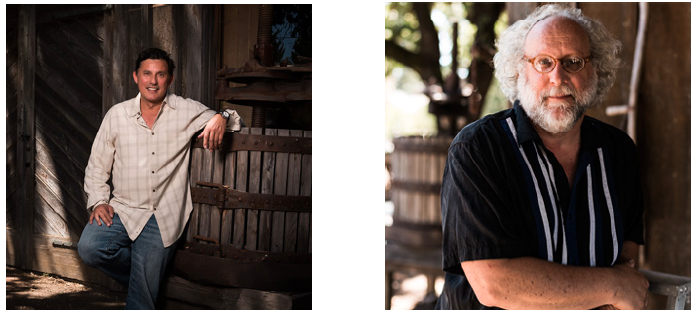 Visit the website at www.e16wines.com for more information and to purchase the E16 wines which are reasonably priced considering the quality. This was my first encounter with this winery and the wines were a pleasant surprise. I remember Moore when he was at Lynmar many years ago and thoroughly enjoyed the Pinot Noirs he produced there.
2012 E16 Santa Lucia Highlands “Upper Bench” Pinot Noir 14.4% alc., 270 cases, $35. Sourced from the upper reaches of Escole Vineyard. Single block of Pommard 4 clone. Aged 11 months in French oak barrels. · Medium reddish purple color in the glass. The nose really attracts attention with vivid aromas of fresh cherries, strawberries, and sandalwood. Soft, even pillowy on the palate with middleweight flavors of red cherries and red strawberries, accented with a hint of cola and oak. A very refined, elegant interpretation of Santa Lucia Highlands fruit with a sleek finish. Score: 92
2012 E16 E16 Selection Sonoma County Pinot Noir 14.5% alc., 600 cases, $35. Primarily a blend from Trenton Road and Bowland Ranch vineyards. 20% comes from Anderson Valley and the Santa Lucia Highlands. Aged 11 months in French oak barrels. · Moderately light reddish purple color in the glass. A lovely nose you could nibble at with bright aromas of red cherry and strawberry. Light to mid weight core of cherry and strawberry fruits with a complimentary backing of spice and an echo of oak. Silky in the mouth, holding up nicely over time in the glass, offering a pleasing kick of citrus on the finish. Score: 89
2012 E16 Russian River Valley “Trenton 1880” Pinot Noir 14.2% alc., 320 cases, $45. Sourced from Singler Family Vineyards owned by Pete and Karrie Singler. The 1880 designation pays homage to the year the first grapevines that were planted in the town of Trenton next to this vineyard. Clone 667. Aged 11 months in French oak barrels. · Moderately light reddish purple color in the glass. Exceptional aromatic explosion of Bing cherry, cardamom spice and cedary oak aromas. Really delicious spiced cherry bombast with plenty of spring and vibrancy. Mild tannins, bright acidity and a cherry-driven, mouth watering finish of uncommon length. My only nit is that a hint of heat shows up on the finish. This wine really draws your attention. Score: 92
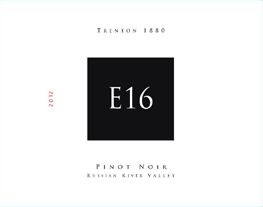
2012 E16 Bennett Valley Bowland Ranch Bennett Valley Pinot Noir 14.4% alc., 295 cases, $40. 3 blocks of Pommard clone from grower Chris Bowland. Aged 11 months in French oak barrels. · Moderate reddish purple color in the glass. Another aromatic bombast with scents of black cherry, earthy flora, and spice. A refined, silky wine that is harmonious, picking up interest over time in the glass. The tasty, mid weight flavors of black cherry, black raspberry and cola are accented with oak and persist noticeably on the suave finish. Score: 91
2012 E16 Anderson Valley “The West End” Pinot Noir 14.7% alc., 220 cases, $50. Sourced from a single vineyard located at the extreme north end of the Anderson Valley. Clone 667 and Pommard. Aged 11 months in French oak barrels. · Moderately dark reddish purple color in the glass. Penetrating aromas of blueberry, black cherry liquor and a hint of mint that comes and goes. The nose becomes somewhat muddled and loses interest over time in the glass. Mid to full-bodied, very ripe black cherry, blueberry and pomegranate fruit flavors with an undertow of oak and a backbone of soft tannins. Plenty of sweet, luscious, juicy fruit that is hard to ignore, but the wine is a touch cloying. Score: 88
Recent Sips of ChardonnayIt is a whole lot easier to make very good to great California Chardonnay than to make noteworthy Pinot Noir. Whether produced with a combination of stainless steel and oak barrel fermentation, partial or full malolactic fermentation or full-throttle 100% oak barrel vinfication, the major aromas and flavors of California Chardonnay come from the winemaking, with differences in regional climates a second important factor. Chardonnay continues to be the most favored varietal among wine drinkers in this country, so it is not surprising that it is the most common white wine vinified by Pinot Noir centric wineries. Because so many Pinot Noir producers send along their Chardonnay for review alongside their Pinot Noir, and since Chardonnay is my white wine of choice, I began reviewing Chardonnay in early 2010. That is not to say that the PinotFile has taken on a “bi” proclivity, and Pinot Noir will forever remain the main emphasis.
2012 Aubert CIX Estate Vineyard Sonoma Coast Chardonnay 15.0% alc.,600 case, $90. This vineyard is planted with the Reuling selection of Chardonnay in 2007. It is located adjacent Lauren Vineyard. · Light golden yellow color and clear in the glass. Wondrous aromas of apple, lemon, pineapple, stone, almond and steel displaying impressive intensity and penetrating quality over time in the glass. A remarkably flavorful wine with notes of lemon curd, baked apple, peach, spice, cashew butter, burnt caramel, nutty oak, and honey with moderate richness. Beautiful oak integration in an unctuous style that is still impeccably balanced. There is no sense of high alcohol in this wine. A distinguished wine offering a bold expression of California Chardonnay. This wine has the balance to last upwards of 10 years. Score: 95
2011 Golan Heights Winery Yarden Galilee Israel Chardonnay 14.5% alc., $20. Grapes grown in the cool climate, rocky volcanic, high altitude soils of the Northern Golan Heights. Barrel fermented and aged 7 months with partial MLF. Kosher for Passover. · Mild golden yellow color and clear in the glass. An array of citrus fruits and pear arrive on the nose, accented by oak-driven notes of toast and nuts. Good fullness and richness, with flavors of lemon curd, quince, pear and pineapple and a complimentary touch of oak. Slightly creamy, finishing with modest citrus-driven acidity. Score: 88
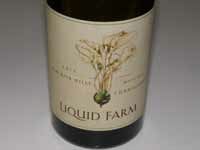 2012 Liquid Farm “White Hill” Sta. Rita Hills Chardonnay 13.8% alc., 988 cases, $40. Sourced from Bent Rock (63%), Zotovich, Kessler-Haak, Rita’s Crown, Huber, Radian and Clos Pepe vineyards. Aged 12 months in neutral oak with 18% stainless steel aging. · Pale golden yellow color and clear in the glass. Aromas of lemon, pineapple, peach, vanilla cream and ocean air. Highly pleasurable on the palate, with crisp lemon-driven flavor accented with baking spice, vanillin, and acid-driven minerality. Modest in weight with a fresh, citrusladen finish. Score: 91
2012 LIOCO Estero Russian River Valley Chardonnay 13.5% alc., pH 3.36, TA 0.65, $35. Harvest Brix 22º. Grapes are grown in Goldridge soils from cooler Russian River Valley sites and include clones 4, 17, 95 and 96. Berries broken before whole cluster pressed. Fermented on lees with battonage for 8 months in large neutral oak barrels. Natural MLF, gentle filtration. · Pale yellow color and clear in the glass. Shy, clean aromas of lemon curd and mixed nuts. Tasty but lean flavors of citrus, baked apple, white grape and stony minerality. Juicy and fresh, but not exuberant and lush like many Russian River Valley Chardonnays. Some may find the wine too delicately flavored while others may welcome the discreet style. Score: 88
2012 LIOCO La Marisma Vineyard Santa Cruz Mountains Chardonnay 13.8% alc., pH 3.46, TA 0.64, $45. Harvest Brix 23º. The vineyard is near the town of Aptos and is a south facing, hillside site 6 miles from the Pacific Ocean. Soils are sand and calcerous marine deposits with ideal drainage. Diurnal temperature fluctuation is 40+º.After intense hand sorting, the berries were broken before whole cluster pressed. Wild yeast fermentation in neutral oak, natural MLF, aged 10 months on lees in barrel and 5 months in tank. · Medium golden yellow color and clear in the glass. Really nice array of aromas including fresh banana, baked pear, exotic honey, and fermented melon. Some richness and slightly creamy, with flavors of lemon curd, baked pear, roasted nuts, burnt caramel, pastry cream and lees. This wine is very unique and presents some flavors that defy description. I like it for its uniqueness and composure. Score: 91
2012 The Wonderland Project “La Reine Blance” (The White Queen) Sonoma County Chardonnay 13.2% alc., residual sugar 0.02 mg, 1,400 cases, $24. Released June 2013. Clone 76 and Robert Young selection. Staggered picks at 21º to 23.5º Brix to control acid. Native yeast fermentation in stainless steel, 100% MLF, aged 8 months in 1/3 new French oak, 1/3 neutral French oak and 1/3 stainless steel. Primarily a restaurant wine meant to be a refined wine at accessible cost but also sold on the winery’s website. Winemaker is former sommelier Matthew Ahern (also of Scribe). · Light golden yellow color and clear in the glass. Clean aromas of lemon curd, honey, spiced peach, papaya, honeysuckle and vanilla bean. Easy to drink with enough acidity to add juiciness, featuring flavors of peach, marzipan, and spice. Slightly creamy and soft in the mouth, with the faintest compliment of oak. A highly enjoyable, nicely balanced, no-nonsense, casual wine that doesn’t weigh you down with alcohol and oak. The ideal proverbial back porch wine. Score: 90
The 2011 Thomas Fogarty Single Vineyard, Estate, Chardonnay collection consists of four wines that hail from the original vines planted at the Fogarty Estate in the late 1970s and early 1980s high in the Santa Cruz Mountains only 10 miles inland from the Pacific Ocean. These vineyards are clustered around the winery and are separated by only a few feet, yet the variability in soil and exposure is reflected in the subtle, but noticeable differences between the wines. The winemaking is nearly identical for each wine so the variations in flavor and texture are mainly site driven. Grapes are harvest in the early morning hours, whole cluster pressed, and undergo a cool, native barrel fermentation. The wines are aged 16-18 months in 50% new French oak, except the Albutom which is aged in 100% used French oak. Planned release date is April 2014. The winemaking team is Michael Martella and Nathan Kandler. As the vines have entered maturity, the winery’s energies have been focused on renewing and invigorating the soil with cover crops, compost, compost tea, and the encouragement of ecological diversity in the vineyards. The vines are dry farmed. The Albutom Vineyard Chardonnay comes from the smallest (.33 acres) parcel. Lambert Shale soils are heavily fractured and feature quarter to basketball size pieces of fractured sandstone throughout the vineyard. Planted in 1981 to clone 4 on A x R1 at an elevation of 1,930 feet with 6’ x 10’ spacing. The Damiana Vineyard is the most protected site on the eastern flank of the ridge line. Clone 4 planted on A x R1 with 6’ x 11’ spacing at 1,890 feet elevation. The fractured shale here features classic Santa Cruz Mountains mudstone that is very fine when weathered, well-drained and mineral rich. The was the original vineyard planted in 1978 at the Estate and usually shows the most opulence and richness of all the wines. The Langley Hill Vineyard is the winery’s largest Chardonnay planting at just over 5 acres. Clone 4 was planted on A x R1 in 1980 with 6’ x 10’ spacing at 1,925 feet elevation. The undulating hillside has a multitude of exposures and varying soils. Heavily fractured shale with scattered colluvium yield wines with minerality and citric fruit. Portola Springs Vineyard (2 acres) is the most unique of the four vineyards in that it is intensely mineral infused with bright acidity and energy. Clone 4 was planted on A x R1 in 1982 with 6’ x 10’ spacing at an elevation of 1,920 feet. The fractured shale here is overlain with silica-rich basalt. This volcanic material was likely flow from nearby Mt. Melville. This wine shows undeniable intensity and tension. A map of the vineyards is below. 2011 was a record late harvest, even exceeding 2010, and amazingly cool. Harvest did not end until November 3. Yields were the smallest ever in most vineyards. Yields averaged around 1 ton per acre. Resulting alcohols were low and acidities high.
2011 Thomas Fogarty Estate Grown Albutom Vineyard Santa Cruz Mountains Chardonnay 13.4% alc., pH 3.17, TA 0.80, 50 cases, $75. Yields 0.46 tons per acre. · Moderate golden straw color and clear in the glass. The nose is challenging to describe as there are many nuances that surface over time in the glass. Scents of pear, yuzu, dried herbs, white pepper and floral accents. A delicate, Chablis-style wine, with flavors of lemon and tart green apple, backed by bracing acidity which chases the saliva on the finish. An echo of lemon persists on the finish for several seconds. Best with acid-loving food like oysters. Score: 91
2011 Thomas Fogarty Estate Grown Damiana Vineyard Santa Cruz Mountains Chardonnay 13.4% alc., pH 3.21, TA 0.76, 96 cases, $60. · Moderate golden straw color and clear in the glass. Delicate aromas of Gravenstein apple, white peach and modest toasty oak do not prepare one for the sensory onslaught to follow. Wow! Amazing attack of lemon, pear, and apple fruits with accents of honey, burnt caramel and cardamom spice. The most intensity of flavor of the four 2011 wines tasted and sporting a long, generous, and juicy, lemon-infused finish. A little less prominent acid themed minerality in this wine. Score: 92
2011 Thomas Fogarty Estate Grown Langley Hill Vineyard Santa Cruz Mountains Chardonnay 13.8% alc., pH 3.13, TA 0.87, 96 cases, $60. · Moderate golden straw color and clear in the glass. Highly aromatic, with bright aromas of croissant, roasted nuts, baked apple and lemon. Plenty of intensity showing lemon curd, baked pear, apple and almond flavors backed by a lively, but integrated, cut of acidity. Very smooth in the mouth with an incredibly bombastic finish that offers waves of lemony goodness returning for what seems like a minute. I have rarely met with a finish like this in Chardonnay. On top of that, the wine is very harmonious with just the right amount of contribution from oak. Score: 94
2011 Thomas Fogarty Estate Grown Portola Springs Vineyard Santa Cruz Mountains Chardonnay 12.3% alc., pH 3.162, TA 0.80, 96 cases, $60. · Moderate golden straw color and clear in the glass. The nose is very bright and clean, with aromas of lemon pie filling, grilled pineapple, seasoned oak and ocean air. The most austere wine so the acid is more evident, but the wine is quite charming. Delicate flavors of citrus fruits and tart green apple have a hint of nutty brittle in the background. Tightly wound, becoming more appealing over time in the glass. This wine will reward cellaring for another few years. Score: 90
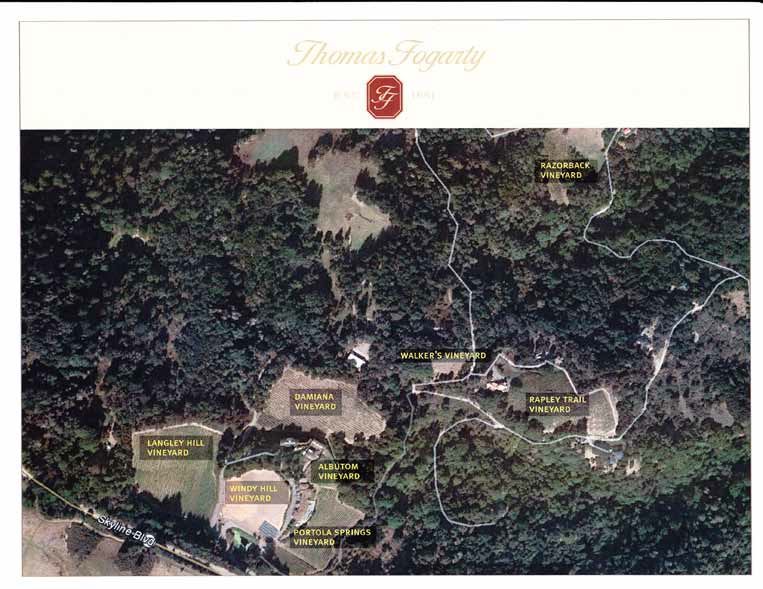
Recent Sips of Other Interesting WhitesTwo surprisingly outstanding Pinot Blancs are included in this list of wines. Pinot Blanc and Pinot Gris arose as independent somatic mutations of Pinot Noir. Somatic mutation is a natural mechanism that allows plant growers to develop new cultivars. Research reported in the Journal of Experimental Botany (November 2012) found that this mutation of Pinot Noir arose independently from the ancestral Pinot Noir, suggesting a novel parallel evolutionary model. Pinot Blanc is fairly widely planted worldwide, but has never received the attention accorded other major white varieties. It probable has garnered its most notoriety from examples grown in northern Italy and Alsace. Its flavor profile mimics Chardonnay, but is lighter and less assertive. New World styles of Pinot Blanc range from a stainless steel fermented, bright, mineral-driven and timid wine to a wine resembling a fat, creamy Chardonnay. Many examples are driven by subtlety, sometimes to the point of blandness, giving the wine a bad rap. No one can say for sure exactly what a great New World Pinot Blanc should be, but the two examples reviewed here will point the drinker in the right direction.
2011 Cutruzzola Riven Rock Vineyard San Luis Obispo Riesling 12.5% alc., $22. Fermented in stainless steel. · Pale yellow color and clear in the glass. Aromas of lemon curd, vanilla, oiled wood and leather boot. Enjoyable flavors of lemon and white peach with a hint of petrol in the background. Slightly creamy with good finishing acidity. A unique expression of dry Riesling. Score: 89
2013 Dutton Goldfield Chileno Valley Vineyard Marin County Riesling 13.2% alc., 380 cases, pH 3.31, TA 0.56, residual sugar dry, $30. From a dry farmed vineyard planted by the Corda family in 1991 to several varieties. When Mark Pasternak took over the farming, he budded everything to Pinot Noir except for 4 acres of Riesling. Harvest in two picks - one on October 22 and one on November 26. 100% stainless steel fermented. · Pale yellow color and clear in the glass. Lovely aromas of peach, grapefruit and a touch of floral goodness. Juicy and flavorful, featuring crisp notes of citrus and white peach with some pleasingly discreet richness, slight creaminess, and a bone dry finish. Delightful. Score: 90
 2013 Dutton Goldfield Dutton Ranch Shop Block Green Valley of Russian River Valley Pinot Blanc 12.8% alc., pH 3.40, TA 0.56, 339 cases, $25. Warren Dutton’s original Graton Road ranch was planted to French Colombard and Gray Riesling when purchased in 1964. In the 1970s, he replaced the Riesling with apples and French Colombard. When it was time to replant the block in 2003, the Duttons decided on Pinot Blanc to augment the adjacent Chardonnay. The vineyard is dry farmed. Stainless steel fermented, partial MLF. · Pale straw color and clear in the glass. Luscious aroma of fresh peaches lemon peel, roasted almonds and the air after a heavy rain. Crisp on the palate, with an intense peach flavor which expands joyously in the mouth and clings to the finish forever. A bit of lemon, lime, grapefruit and vanilla flavors add interest. Beautifully balanced with well-integrated acidity and a silken mouth feel. This is one sexy peach of a wine. Score: 92
2012 Golan Heights Winery Galilee Israel Moscato 7% alc., $14. Grapes grown in the volcanic soils of the Golan Heights. Fermentation blocked early to produce an aromatic wine that is lively and semi dry. Kosher for Passover. · Pale golden yellow color and clear in the glass. Highly aromatic with vivid aromas of peach, mango and lychee. Vibrant and flavorful core of white peach with accents of lychee and nuts. Soft and smooth on the palate with some, but not overbearing, sweetness. Ideal chilled as an aperitif or an accompaniment to a peach dessert such as peach melba. Score: 88
2012 Harper Voit Maresh Vineyard Old Vine Dundee Hills Riesling 12.2% alc., pH 2.95, TA 0.895, residual sugar 1.3%, 75 cases, $25. From own-rooted, gnarled vines planted in 1979. No MLF. · Pale yellow color and clear in the glass. Aromas of citrus, honeysuckle and petrol lead to flavors of grapefruit, Asian pear and lemon with a citrus-infused, off-dry, and electric finish. A wine searching for food. Score: 88
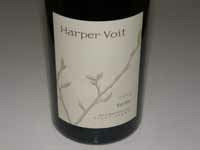 2012 Harper Voit Surlie Willamette Valley Pinot Blanc 13.6% alc., pH 3.10, 225 cases, $20. Sourced from Crannell Vineyard in the Eola- Amity Hills and Meredith Mitchell Vineyard in McMinnville. Barrel fermented in used French oak, no MLF, aged on lees for 9 months. · Very light golden yellow color and clear in the glass. Highly aromatic with effusive aromas of baked apple, Limoncello, pear, pastry cream and a subtle yeasty note. Delicious and bright on the palate with an array of layered flavors including apple, pear, and citrus, finishing with a green apple note and palate cleansing acidity. This is the most interesting Pinot Blanc I have ever had from Oregon, and a great shellfish wine. Score: 91
2012 Smith-Madrone Spring Mountain District Napa Valley Riesling 12.5% alc., pH 3.12, residual sugar 0.41%, 798 cases, $27. Vines grown in red, rocky volcanic soil. 5.5 acres of 40-year-old, dryfarmed Riesling planted along with Chardonnay and Cabernet Sauvignon adjacent encroaching forest of Madrone - hence the name. · Pale yellow color and clear in the glass. Delicate aromas of lemon zest, green apple, peach and toast. Flavorful range of citrus fruits and peach with a note of iron-driven minerality and bright acidity. Has the goods to age for many years. Score: 90
NV Sokol Blosser Winery Evolution American White Wine 12.0% alc., residual sugar 1.2%, $15. A blend of 9 white varietals including Pinot Gris, White Riesling, Muscat, Gewürztraminer, Müller- Thurgau, Semillon, Pinot Blanc, Sylvaner and Chardonnay. 17th edition. Fermented in 100% stainless steel, fff dry. · A unique wine that offers no special varietal correctness. The aromas are complex and include lemon, dried mango, honeysuckle, pastry cream and roasted almonds. On the palate, the delicately flavored wine is bright and easy to like, with tastes of pineapple, pear eau de vie, spice and citrus infused with bright, refreshing acidity and a very slight finishing sweetness. Very versatile at the table, and can shine with Thai curry, Tandoori chicken, spicy tune rolls or baked sole with lemon butter. Score: 88
2012 Yalumba “Y” South Australia Viognier 14.5% alc., $9.49, screwcap. Imported by Negociants USA Inc., Napa, CA. Yalumba has quite a reputation for Viognier, but this is their entry level offering. Yalumba is Australia’s oldest family owned winery. · Light golden color and clear in the glass. Marked reduction upon opening with strong burnt match aromas. Soft and pleasing on the palate with flavors of lemon curd, grilled pineapple, and mango. Much better two days later from a previously opened and re-corked bottle with no reduction evident and more vivid tropical fruit flavors, although still somewhat dilute. Score: 86
Recent Sips of Pinot Noir
2012 AEQUOREA Seafarer San Luis Obispo County Pinot Noir 14.5% alc., $38. · Moderate reddish purple color in the glass with an unfiltered appearance. Aromas of oak-kissed cherry and spice. Nicely composed with mid weight flavors of cherry pie, raspberry and cranberry with a noticeable oak sheen. The tantalizing red fruits leave a pleasing impression on the mid palate and expand through the finish that offers some persistence. Very creamy the following day from a previously opened and re-corked bottle. Score: 89
Bohème is project of Kurt Beitler, whose uncle is Chuck Wagner of Caymus fame. In 2000, Wagner charged Beitler with farming his Pinot Noir vineyard, Taylor Ridge, located near Occidental. This led to an epiphany about the sensational Sonoma Coast wines. The name of the winery comes from the Bohemian Highway that runs through Occidental. The bohemian spirit implies individual, artistic and virtue. Beitler grows all the vineyards from which he makes wine - about 20 acres in three different locales. His winemaking approach is traditional, except that he uses no new oak in the aging process. This produces wines with less tannin, more elegance, and no added sweetness and spice that comes with new oak exposure. Visit www.bohemewines.com.
2010 Bohème Stuller Vineyard Sonoma Coast Pinot Noir 14.3% alc., 285 cases, $49. Vineyard is located at 1,209 feet elevation on a coastal ridge, 6.4 miles from the Pacific Ocean. Clones 115 and 667. Yield .99 tons per acre. Aged 2 years in neutral French oak barrels. From owner-vintner Kurt Beitler. · Moderately light reddish purple color in the glass. Cherry is the dominant scent on the nose with added compliments of forest floor and leaf. Earth-kissed cherry flavor with hints of raspberry and dark chocolate. Very mild tannins and easy to drink, but a little delicate for my taste on the attack and finish. Score: 88
2010 Bohème Taylor Ridge Vineyard Sonoma Coast Pinot Noir 14.5% alc., 189 cases, $55. Vineyard is at 915 feet elevation, 5.3 miles from the Pacific Ocean. Swan selection, yields 1.09 tons per acre. Aged 2 years in neutral French oak barrels. · Light reddish purple color in the glass. Nicely perfumed with aromas of red cherry, Christmas spice and sandalwood. Soft and elegant in the mouth with supple tannins backing the delicious core of red cherry and cranberry fruits. A delicate wine, but flavorful and very enjoyable. The cherrythemed finish is noteworthy. Score: 90
2010 Bohème English Hill Vineyard Sonoma Coast Pinot Noir 14.1% alc., 221 cases, $49. This vineyard is located on the southwestern edge of the Russian River Valley. Clones are 115, 667, Vosne-Romanee, and Calera selections. Yield .89 tons per acre. Aged 2 years in neutral French oak barrels. · Plenty to like on the nose with uplifting aromas of black cherry, spice and earthy flora. Elegant and suave, with darker stone and berry fruits augmented with cinnamon spice. There is a good cut of acidity and some finishing persistence. Score: 89
2012 Cambria Julia’s Vineyard Santa Maria Valley Pinot Noir 13.5% alc., pH 3.60, TA 0.58, $25. An amalgam of different clones and vine ages with some very old vines dating to 1974. Named after proprietor Barbara Banke’s youngest daughter Julia. Clones 4, 2A, 23, 667, 115, 12, 5 and 777. 7-day cold soak, aged 7 months in 20% new French oak barrels. · Medium reddish purple hue in the glass. This wine is often one of my favorite value priced offerings, but this edition has too much oak sheen for my taste which is surprising since the percentage of new oak is very modest. The fruit aromas of dark cherry and blackberry are overshadowed by oak. The lovely fruit core of black cherry, blueberry and pomegranate is earth-blessed, but somewhat buried in oak-driven flavors of tobacco and toast. The finish is satisfying but offers a rush of tannin. Another 6 to 12 months in bottle should mitigate some of the tug of oak and soften the tannins. Score: 87
2011 Colene Clemens Vineyards Margo Estate Chehalem Mountains Pinot Noir 13.2% alc., $34. · Moderate reddish purple color in the glass. Aromas of cherry, rose petal and sandalwood emerge slowly over time in the glass. Very similar to Adriane but with darker fruit flavors of black cherry and sassafras with a pleasant oak sheen. Light to medium weight with balanced tannins and a very dry finish. Seems a bit tight and should benefit from a year in the cellar. Score: 89
2011 Colene Clemens Vineyards Adriane Estate Chehalem Mountains Pinot Noir 13.5% alc., $45. · Moderate reddish purple hue in the glass. Rather shy aromas of oak-shaded black cherries. Mid weight core of red and black cherries and cranberries with tobacco-laced oak in the background. Well-managed tannins and some finishing length, becoming better over time in the glass. When tasted the following day from a previously opened and re-corked bottle, the oak-kissed red cherry theme persisted. Could use a little more time in bottle. Score: 90
2011 Colene Clemens Vineyards Victoria Estate Chehalem Mountains Pinot Noir 13.3% alc., $58. · Moderate reddish purple color in the glass. Expressive aromas of dark cherry liquor, black raspberry jam, spice and briar. The most polished and rich wine of the three 2011 Pinot Noirs, featuring a flavorful core of dark cherry accented with spicy oak. Very harmonious, but not fully forthcoming and will need a year or two in the cellar. Score: 91
2012 Drew Gatekeepers Mendocino Ridge Pinot Noir 13.2% alc., $32. Grapes are from Valenti and Perli vineyards. 60% 667, 25% 777 and 15% Rochioli selection. Harvest Brix 22º-23º. 15% whole cluster fermentation. 100% native fermentation. 10% new French oak barrels. · Moderately light reddish purple hue in the glass. Nicely perfumed with scents of fresh cherry pie glaze, spice, toast and sunflower seed. Elegant and fresh, with mid weight flavors of black cherry, raspberry, and cranberry with a touch of spice and oak. Tangy acidity and mild fine-grain tannins. Plenty of verve to grab on and hold through a long, cherry-themed finish. Very generous in its youth, but fine the following day from a previously opened and re-corked bottle indicating it can be cellared for several years. Score: 90
2012 Drew Morning Dew Ranch Anderson Valley Pinot Noir 13.0% alc., $55. Vineyard is owned by Burt Williams and located in the deep end of the Anderson Valley on a steep, south-facing hillside. Multiple field selections including Rochioli and La Tache “828.” Harvest Brix 22.5º-23º. 30% whole cluster fermentation. 100% native fermentation. 33% new French oak barrels. · Moderately light reddish-purple color in the glass. Intoxicating aromas of black cherry, red grape, brown spice and sandalwood. Refined and elegant in style, with deep cherry and red raspberry flavors underlain with hints of spice and stem. A complete wine with balanced tannins, refreshing acidity and a long, bright, raspberry-infused finish with no hard edges. Good for long-term cellaring but thoroughly enjoyable now. Score: 92
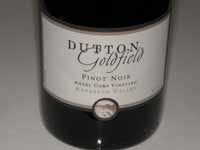 2012 Dutton-Goldfield Angel Camp Vineyard Anderson Valley Pinot Noir 13.5% alc., pH 3.66, TA 0.59, 306 cases, $58. This vineyard is owned by Dan Goldfield’s good friend Brian Zalaznick, who planted this 11.5-acre vineyard in memory of his brother and family. It is located west of Philo on a knoll above the Navarro River, overlooking the valley. 100% de-stemmed, 5-day cold soak, co-fermentation of clones (Pommard, “828,” and 667), 50% of press wine added back to enhance aromatics, aged 11 months in 50% new French oak barrels. · Moderately dark reddish purple robe in the glass. This is one of those wines that you know is special from the get-go. Enormous aromas of black raspberry, black cherry, spice and sweet oak. Medium to full bodied and lush, it is crammed with zesty black cherry and black raspberry fruit with an undertone of cola, Asian 5-spice and dark chocolate. The tannins are modest and fine-grained, the lip-smacking acidity adds juiciness, and the supple finish is remarkably long and focused. The wine holds up beautifully after an hour in the glass. Like biting into a just picked, perfectly ripe black raspberry. An absolute knockout! Score: 94
13.5% alc., pH 3.64, TA 0.58, 498 cases, $58. This vineyard just outside the town of Graton was planted by Steve Dutton in 2001. Clones are Pommard, Wädenswil 2A, and “828” in Goldridge soil. 100% destemmed, 5-day cold soak, each clone fermented and handled separately, aged 11 months in 55% new French oak barrels. · Moderately dark reddish purple color in the glass. The nose is very shy initially and evolves reluctantly over time to reveal aromas of blackberry preserves, blueberries, and an appealing floral note. Mid weight flavors of blackberry, blueberry, pomegranate and Tootsie Roll with a touch of spice, backed by suave, dusty tannins and good acidity. Texturally interesting and soft in the mouth, with admirable balance, and a generous dark berry driven finish. Decant this beauty if you must open now, but it will be more giving with another year or two in bottle. Score: 92
2011 Elk Cove Mount Richmond Willamette Valley Pinot Noir 13.5% alc., $34. This vineyard is located on a steep southeast facing slope with well-drained Willakenzie soil. Planted in 1996 with cuttings from Elk Cove’s Roosevelt Vineyard. · Moderate garnet color in the glass. Deep aromas of cherry, strawberry, leather wallet and oak. Satisfying flavors of cherry and red berries with complimentary oak in the background. Supple tannins with a tangy, cherry themed finish. A good food wine. Score: 90
2010 EN GARDE Russian River Valley Pinot Noir 13.8% alc., $48. Unfined and unfiltered. · Light reddish purple color in the glass. Initially, the aromas of red strawberry, red cherry, spice and sandalwood are quite charming, but oak dominates over time in the glass. Light weighted flavors of red berries, rhubarb and cherry with a tarry oak note that intrudes in the background. Supple tannins and some finishing intensity. Score: 87
2010 EN GARDE Russian River Valley Reserve Pinot Noir 14.5% alc., $58. Unfined and unfiltered. · Moderately light reddish purple hue in the glass. Deep, glorious aromas of black cherry with a hint of spice and sandalwood. More structure and finish and a riper fruit profile than the regular bottling offering flavors of black cherry, plum reduction sauce, cola, dark chocolate and anise. The fruit pushes the ripeness envelope resulting in a cooked fruit tone and a little heat peaks out on the finish. Score: 87
2011 EN GARDE Russian River Valley Pinot Noir 13.5% alc., $48. Unfined and unfiltered. · Moderately light reddish purple color in the glass. Aromas of strawberry, cut flowers and sandalwood. Mid weight flavors of strawberry, raspberry with a compliment of nutty oak. Noticeable tannin and zippy acidity producing a tangy finish of some length. Score: 89
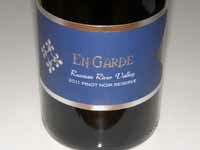 2011 EN GARDE Russian River Valley Reserve Pinot Noir 13.8% alc., 100 cases, $58. Unfined and unfiltered. · Moderately light reddish purple color in the glass. Very nice perfume of Bing cherry, raspberry, caramel and spice. Tasty essence of Bing cherries with a long cherry-driven finish. Seamless with balanced t n‘ a. Juicy and very satisfying. Highly accessible now, but has the balance to age effortlessly. Score: 91
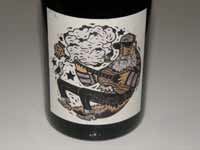 2012 Eric Kent Small Town Sonoma Coast Pinot Noir 13.7% alc., pH 3.61, TA 0.66, 382 cases, $48. Released spring 2014. 44% Cleary Ranch and Michael Valentine, 31% Grand Vent, 13% Stiling, 12% Roberts Road vineyards. Clones 667, 777, Swan, Pommard and 113. Celebrating tens years of wine and art. · Moderate reddish purple color in the glass. Attractive aromas of cherry and baking spices with a little dark chocolate showing up over time. Middleweight flavors of black cherry, black raspberry, cola and sassafras, with a hint of tarry oak and orange zest showing up on the long, palate-cleansing, juicy finish. The tannins are nicely managed and the acid adds zest and vibrancy. Develops more interesting nuances over time in the glass. Score: 93
2012 Geyser Peak Winery Pluto’s Fury Russian River Valley Pinot Noir 14.4% alc., pH 3.55, TA 0.60, 500 cases, $28. Pluto’s Fury takes its name from one of the historic geysers that dot the landscape around the winery. Historically, the geysers were located in an area of mineral wealth and were given colorful names derived from Greek mythology, stemming from the belief that mineral wealth originated in the domain of Pluto. Winemaker Ondine Chattan. Aged 11 months in 100% new French oak barrels. · Moderately light reddish purple color in the glass. Appealing aromas of cherry, brown spice, mushroom and sweet oak. A lighter weight, easy drinking wine that is soft and silky in the mouth. The flavors of cherry, strawberry and oak spice are enjoyable, and there is commendable harmony. The finish is pleasant but not remarkably long. A solid wine for the daily table. Score: 88
 2011 Gundlach Bundschu Heritage Selection Sonoma Coast Pinot Noir 14.2% alc., pH 3.83, TA 0.56, 308 cases, $N/A (allocation only). Released March 2014. Grapes are from the Bundschu family’s 150+year-old vineyard located on the southwestern slopes of the Mayacamas Mountains, eight miles north of San Pablo Bay. Huichica clay loam with gravel deposits. Two distinct blocks of 40+year-old Heritage vines were harvested and vinified separately for this limited barrel selection bottling. 7-day cold soak, indigenous yeast and malolactic, partially fermented in upright open-top French oak puncheons, aged 14 months in 50% new French oak barrels. · Moderately dark reddish purple color in the glass. Effusive aromas of black cherry, blueberry, rose petal and spice rub. Striking flavor attack on entry with plenty of dark cherry and black raspberry fruit that really pops! Hints of anise, black tea and nuts from supportive oak add interest. Very soothing in texture with balanced fine-grain tannins and a drawn out finish. A unique, nuanced wine that changes constantly in the glass. An argument for old vine Heritage clones. Score: 94
Hirsch Vineyards experienced a marvelous 2011 vintage, with a difficult spring (cold, winds and rain) evolving into a cool, clear summer. The skies were clear and dry, temperatures were consistently moderate, and the weather was equable throughout the crucial growing season and veraison. Physiological development was in harmony with fruit and sugar development. Fruit from all 60 farming blocks reached maturation at about the same time, but a shortage of harvest labor forced crews to start work around midnight initially, then as early as 7pm, and work until mid morning. The crew was working 14 hour days to pick pristine fruit and keep ahead of the rain. By October 2, all but two acres were in (a client wanted to wait out the rains for more sugar ripening) and then over 6 inches of rain fell. David Hirsch points out the vines don’t do much below 50º F and above 95º F. At the vineyard’s latitude, 38 north, temperatures above 75º F drive vegetative growth and sugar ripening if the skies are clear at the expense of ripening for flavor, aroma, depth and tannin development. It is in the sweet spot of 65º F to 80º F with good sunlight that the vine expresses its full development in the vintage, and by doing so, elaborates the potential of its site. This miracle occurred in 2011. Hirsch Vineyard lies but 2.5 miles from the San Andreas Fault on the extreme western Sonoma Coast. It consists of a single vineyard of 68 acres divided into 61 individual farming blocks. The resulting degree of fragmentation is unmatched even by the famously subdivided vineyards of the Côte de Nuits. There is a far ranging variety of soils, topography and microclimates. Each block is individually developed and farmed, harvested and vinfied separately.
2011 Hirsch Vineyards San Andreas Fault Sonoma Coast Pinot Noir 13.4% alc., pH 3.47, TA 0.59, 3,091 cases, $60. The winery’s signature wine that represents the entirety of this multifaceted vineyard. This wine has fruit from 27 distinct farming blocks, more than any other wine made from the Hirsch Vineyard. Vines planted between 1980 and 2003. Clones are Pommard and Wädenswil (48%), Swan (21%), 777 (14%) and small amounts of Mt Eden and 114. 10% whole cluster inclusion. Aged 18 months in 35% new French oak barrels. Second vintage crafted by winemaker Ross Cobb. · Moderately light reddish purple color in the glass. A haunting, searching perfume of black fruits, spice box, rose petal and herbs. Mid weight flavors of plum, boysenberry and cassis that are ripe and pure framed by balanced tannins. Invigorating and accessible, with an explosive finish of uncommon length. Score: 92
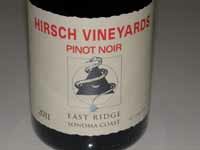 2011 Hirsch Vineyards East Ridge Sonoma Coast Pinot Noir 13.4% alc., pH 3.39, TA 0.62, 301 cases, $85. East Ridge is a distinct microsite within Hirsch Vineyard, comprising an area of 18 acres divided into 16 farming blocks. This wine is a selection of the very best barrels from five of the oldest blocks on the East Ridge. 58.3% Pommard and Wädenswil, 33.3% Mt Eden and 8.3% Swan. Vines planted between 1990 and 1998. 20% whole cluster inclusion. · Moderate reddish-purple color in the glass. Pure, clean aromas of blackberry jam, Hoison sauce, spice and damp soil. More intensity and length here, with rich flavors of earth-kissed purple and black fruits flooding the palate, complimented by a dusting of tannins and a bright spark of acidity. The wine finishes with an immensely satisfying finish that goes on and on. Terrific juice. Score: 94
2011 Hirsch Vineyards West Ridge Sonoma Coast Pinot Noir 12.8% alc., pH 3.42, TA 0.61, 195 cases, $85. West Ridge is a series of hilltop vineyard blocks along the main ridge of Hirsch Vineyard covering 28 acres and divided into 27 farming blocks. This bottling is a selection of the most exceptional barrels from three of the very best blocks on West Ridge. 50% Mt Eden, 47.5% Swan and 12.5% Pommard and Wädenswil. Vines planted between 1992 and 1995. 10% whole cluster inclusion. Aged 18 months in 25% new French oak barrels. · Moderately light reddish purple hue in the glass. Delicate, but pleasing aromas of red cherry, raspberry jam and Christmas pine. Lighter and more elegant, with a little more oak sheen overshadowing the crisp cherry and raspberry fruit. More citrus-driven acidity in this wine that offers very suave tannins and easy accessibility. A more feminine wine, but like the San Andreas and East Ridge bottlings, a very long and tantalizing finish. Score: 92
Jamie Kutch has experienced remarkable growth in 2012 with the production of the first vintage in a new Sonoma facility and the arrival of 30 new tanks including Grenier 4-ton wood tanks from France (the same as used at DRC). The 2012 growing season on the Sonoma Coast was seamless in Jamie’s words. Because of the quality of the grapes, everything was fermented with 100% whole cluster (stem inclusion). The wines had a darkness of color that exceeded any previous harvest at Kutch. The wines were bottled January 27, 2014. Visit www.kutchwines.com.
2012 Kutch Sonoma Coast Pinot Noir 13.2% alc., $39 ($78 per magnum). A blend of two-thirds Campbell Ranch located on a rugged portion of the true Sonoma Coast, and one-third from Sonoma Stage Vineyard on the northern edge of San Pablo Bay. 100% whole cluster. · Deep, dark reddish purple color in the glass. Complex nose with expressive aromas of blackberry, cassis, and whole cluster spice and floral goodness. The full Monty with thick, broad flavors of dark berries, black currants, spice and slate. Although sappy, the wine is not cloying. The sinewy tannin structure is neither astringent or particularly intrusive, but bottle aging will lead to more softness and integration. The finish is satisfying but shy at this stage. Amazing phenolic ripeness at this low alcohol level. Still quite aromatic the following day from a previously opened and re-corked bottle. Best to cellar for a few years at least. Score: 90
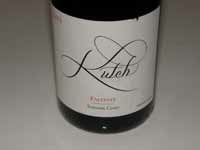 2012 Kutch Falstaff Vineyard Sonoma Coast Pinot Noir 12.9% alc., $59. Falstaff has a shallow layer of Goldridge soil over marine sandstone that imparts a minerality to the wine. 100% whole cluster. · Deep, dark reddish purple color in the glass. Brooding aromas of blackberry jam, black currant, anise and smoky oak. Remarkable fruit intensity with a full-on array of dark berry fruits embellished with hints of spice and earthy goodness. The wine exhibits a tannin-filled personality that is in balance with the prodigious fruit. Very soft and smooth in the mouth with a long, fruit-laden finish. More aromatic with the telltale floral and spice attributes of whole cluster and more flavorful the following day from a previously opened and re-corked bottle. Tremendous potential that will require several years of cellaring, but can be enjoyed now with decanting. Score: 92-93
2012 Laetitia Estate Arroyo Grande Valley Pinot Noir 13.9% alc., pH 3.56, TA 0.62, 27,240 cases, $25. Harvest Brix 23.6º-26.1º. Clones 113, 115, 459, 667, 777, “828,” Pommard 5, Wädenswil 2A, Martini 13 and Mt. Eden. De-stemmed, 3-day cold soak, quick fermentation lasting 4 days, aged for 11 months in 30% new and 70% neutral Francois Frères and Rousseau French oak barrels. · Moderate reddish-purple color in the glass. Sweet aromas of spiced raspberry, cherry, strawberry and a hint of vanilla. An easygoing, very flavorful mid weight wine with polished tannins. A red fruit brigade is featured with plenty of spice, finishing with a flourish of slightly tart red cherries. Eager to be enjoyed now. Widely available in the retail marketplace. Score: 89
2012 Laetitia Reserve Du Domaine Arroyo Grande Pinot Noir 14.3% alc., pH 3.78, TA 0.61, 1,200 cases, $40. Harvest Brix 23.8º-26.8º. Composed of fruit that is given a longer hang time on the vine and a longer period of aging in oak. It is the winery’s Tête de Cuvée representing the paramount of the vintage. Aged 11 months in 40% new and 60% neutral French oak barrels. Clones 115, 667, 459, “828,” Wädenswil 2A and Martini 13. · Gorgeously composed nose of black cherry black raspberry and spice aromas. Concentrated and strapping, with layers of chewy black cherries and dark berries, yet refined and polished with impeccable balance for the long haul. The finish delivers loads of extended pleasure. This wine has the backbone to age well into ten years but is irresistable now. Score: 92
 2012 Laetitia Whole Cluster Arroyo Grande Pinot Noir 14.2% alc., pH 3.78, TA 0.59, 420 cases, $40. Harvest Brix 23.8º-26.8º. 45% whole cluster maceration and fermentation. Aged 11 months in 50% new French oak barrels. · Moderate reddish-purple color in the glass. Better be sitting down when you drink this knock out wine. Copious aromas of black cherry, spice, rose petal and other exotic flowers. Reminds me of a classy woman’s perfume. Seamless and sensual on the palate, offering a festival of spiced black cherries and black raspberries with perfectly integrated tannins and acidity, and a long, supple finish that leaves an impression. Everything good about whole cluster is exemplified in this beauty that has that magical je ne sais quoi that makes people go ga-ga over some red Burgundies. Score: 95
2011 Lea Sta. Rita Hills Pinot Noir 14.3% alc., 635 cases, $32. A blend from Turner, Buona Terra and Moorman vineyards. · Moderately dark reddish purple color in the glass. Aromas of black cherry, tea leaves and hay. Straightforward and accessible with flavors of black cherry and dark red berries accented by dusty oak in the background. This wine grows on you over time, offering a notable long finish with a good acid tang. Score: 89
2012 Longoria Lovely Rita Sta. Rita Hills Pinot Noir 13.8% alc., pH 3.40, TA 0.64, 405 cases, $32. Grapes are from Fe Ciega Vineyard. Harvest Brix average 23.0º. Primarily Pommard clone. 100% de-stemmed, aged 15 months in 20% new French oak barrels. Gently fined and filtered two weeks before bottling. · Moderate reddish purple color in the glass. Deep aromas of boysenberry, black cherry, forest floor, herbal oak and salinity. Enjoyable core of fresh, sweet red, spiced cherry and berry fruit. Nicely crafted, with mild tannins and a citrus-infused finish. Winemaker Rick Longoria advises a cellaring potential of 4 to 8 years. Score: 88
2012 Longoria Bien Nacido Vineyard Block N Santa Maria Valley Pinot Noir 14.4% alc, pH 3.51, TA 0.59, 168 cases, $45. 20th vintage of Pinot Noir that Longoria has produced from this vineyard. Block N is one of the original blocks of Pinot Noir at Bien Nacido planted in the 1970s. Harvest Brix 23.8º. 100% de-stemmed, 3- day cold soak, inoculated 7-day fermentation. Aged 14 months in 33% new French oak barrels. · This is a very distinctive wine. Moderately dark reddish purple hue in the glass. The nose starts off with prominent notes of evergreen tree and tomato leaf with a hint of black raspberry and cherry. Over time in the glass, the vegetal notes recede and the fruit is more sparkling. Similarly on the palate, the earthy dark cherry and raspberry fruit is clothed in tobacco leaf and dried herb flavors initially, shedding those notes over time in the glass and developing more pure fruit flavors. This unique wine grows on you over time, with the herbal notes declining and becoming more complimentary. Decant or hold this wine in your cellar for a year or two. Score: 90
2012 Longoria Fe Ciega Vineyard Sta. Rita Hills Pinot Noir
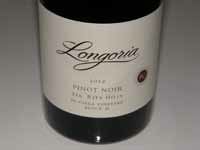 2012 Longoria Fe Ciega Vineyard Block M Sta. Rita Hills Pinot Noir 14.3% alc., pH 3.20, TA 0.60, 67 cases, $55. Second vintage produced exclusively from fruit planted in the 1.25-acre Block M of Fe Ciega Vineayrd. Mt. Eden Clone. 100% de-stemmed, 3-day cold soak, inoculated 14-day fermentation. Aged 25 months in 55% new French oak. Lightly filtered, but not fined. · Dark reddish purple color in the glass. The nose is very ingratiating, offering plenty of dark red and black berry fruit aromas. In fact, one sniff of this beauty and you know that you are in for something special. Delicious, perfectly ripened flavors of black raspberry, black cherry and plum reduction sauce. Medium to full bodied with round, dry tannins, a very polished mouth feel and a long, long finish. Clearly a very classy wine that any red-blooded pinotphile will adore. Score: 94
2012 Sante Arcangeli Family Wines Split Rail Vineyard Santa Cruz Mountains Pinot Noir 14.1% alc., pH 3.65, 245 cases, $36. the vineyard is located 1,700 feet above Monterey Bay in Corralitos. An unusual combination of David Bruce selection, UCD 32 (Roederer clone) and Pommard clone. Harvest Brix 23º-25º. 10% whole cluster inclusion. Native and AMH yeast fermentation. Aged 10 months in 90% French and 10% Hungarian oak barrels, 50% new and 50% used. Bottled unfiltered in August 2013. · Light reddish purple color in the glass. Gentle aromas of cherry, strawberry and baking spices lead to a light, elegantly styled wine with flavors of cherry, raspberry and strawberry complimented by hints of cola, herbs and oak. Bright and juicy with charming Pinot modesty. Score: 90
The following Siduri wines have only been in bottle 10 weeks and some are not scheduled for release until June of this year. Taking this into account, I decanted several wines and tasted all of them over an extended period. I have given a range of scoring with the consideration that several wines should improve with more time in bottle. The wines may warrant higher scores with an additional 6-12 months in bottle. All wines are bottled under screwcap.
2012 Siduri Chehalem Mountains Pinot Noir 14.1% alc., 1,175 cases, $32. Released April 2014. · Moderately light reddish purple color in the glass. Fantastic nose with hi-tone aromas of fresh strawberries, cherry pie, spice and oak accent, holding up over time in the glass. Mid weight, juicy array of red cherry and berry fruits backed by supple tannins and good acidity. An elegant, fruit-forward, very accessible wine. Score: 88
2012 Siduri Arbre Vert Vineyard Willamette Valley Pinot Noir 14.1% alc., 399 cases, $42. Released April 2014. · Moderately light reddish-purple color in the glass. A festival of earth-kissed cherry fruit on the nose and palate with riffs of clove and citrus, opening slowly over time in the glass. Discreetly concentrated, softly textured and harmonious, with an oak skirt showing. Some length in the mouth and finish with a little grip of tannin and citrus on the finish. Still not very showy the following day from a previously opened and re-corked bottle. Definitely needs another 6 to 12 months in bottle for most enjoyment. Score: 89
2012 Siduri Muirfield Vineyard Willamette Valley Pinot Noir 14.1% alc., 211 cases, $42. Release June 2014. · Moderately light reddish purple color in the glass. The nose is inviting with deep aromas of darker cherries and berries, forest floor and savory highlights. Middleweight core of black cherry fruit which is nicely ripened and bright. Fairly bold with a substantial tannic backbone and a juicy finish with hints of citrus and irondriven minerality. About the same the following day from a previously opened and re-corked bottle. This wine could use another year in bottle. Score: 90
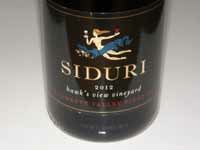 2012 Siduri Hawk’s View Vineyard Willamette Valley Pinot Noir 14.1% alc., 235 cases, $42. Release June 2014. · Medium reddish purple hue in the glass. The most flamboyant and interesting nose of the Oregon offerings with aromas of black cherry, sassafras, forest floor and graham. Pleasing flavors of black cherry, black raspberry with good fullness and polish on the palate. Impressive persistence on the fruit-filled finish which leaves a modest amount of tannins in its wake. When tasted the following day from a previously opened and recorked bottle, this was clearly my favorite with the most memorable finish of the 2012 Oregon offerings. Will only improve in the cellar. Score: 92
2012 Siduri Sonoma Coast Pinot Noir 14.1% alc., 2,232 cases, $32. Sourced from Pratt Vineyard-Sexton Road and "828" from Camp Castro Vineyard with some Sonatera Vineyard and a few barrels of Hirsch Vineyard. Released April 2014. · Moderately dark reddish purple color in the glass. Fresh aromas of berries, black grapes, forest floor, toast, vanilla and leather. Mid to full bodied core of black raspberry and blackberry fruits backed by muscular tannins. Finishes with reasonable length and intensity leaving some oak and tannin behind. Should be better in 6 months. Score: 88
2012 Siduri Sonatera Vineyard Sonoma Coast Pinot Noir 14.3% alc., 368 cases, $48. Release June 2014. · Moderately dark reddish purple color in the glass. Appealing aromas of cherry pie glaze, raspberries and exotic wood. Rich and luscious flavors of dark plum, black cherry, sassafras and spice with complimentary oak and balanced tannins. A pleasurable, fruit-driven wine with a plush mouth feel. A touch of heat shows up on the finish. Score: 89
2012 Siduri Hirsch Vineyard Sonoma Coast Pinot Noir 14.1% alc., 276 cases, $55. Release June 2014. Three new sections of vineyard added in 2012 as original section sourced wince 1995 was largely pulled out due to disease. A selection of 39% of the barrels for the final wine. 5 barrels of Pommard, 3 barrels each of Mt Eden and 114. · Moderate reddish purple color in the glass. Very reticent, but shows tremendous potential. Aromas of black cherry, blackberry jam and sassafras. Mid weight flavors of black raspberry, black cherry and pomegranate with an earthy, leathery undertow. Very classy fruit with well managed tannins and admirable balance. Not particularly interesting now, but the pedigree shows through. Should be a killer in a year or two. Score: 91
2012 Siduri Van Der Kamp Vineyard Sonoma Mountain Pinot Noir 14.6% alc., 207 cases, $44. Release May 2014. · Medium reddish purple color in the glass. The nose unfolds slowly in the glass to reveal bright aromas of black cherry, black raspberry, tea and wet leaves. Very tasty, with a classy core of black cherry, blueberry and pomegranate fruits backed by sweet oak. The tannins are firm but refined and the finish is spectacularly long. The higher alcohol is evident in the background, but this is a trade off for the sweet, luscious fruit presence. Score: 91
2012 Siduri Ewald Vineyard Russian River Valley Pinot Noir 14.9% alc., 257 cases, $48. Release May 2014. 3-acre site planted in Goldridge soil tucked just behind Kistler Winery. Harvest Brix 23.2º-24.2º. 11 out of 29 barrels chosen for the final wine. About 35% new French oak. · Dark reddish purple color in the glass. Complex nose with aromas of black cherry, black raspberry, briar, pine, spice rub, and others I could not pinpoint. Full-bodied, sweet and sappy, with a plethora of black fruits. Tremendous luscious fruit intensity with matched tannins. Complimentary oak in the background. The wine becomes softer and more cohesive with more nuance over time in the glass, but make no mistake, this is a fruit driven wine. Score: 90
2012 Siduri Lingenfelder Vineyard Russian River Valley Pinot Noir 14.3% alc., 211 cases, $48. Release June 2014. · Medium reddish purple color in the glass. Very aromatic, with expressive scents of cherry, nutmeg and rose petal. Good attack and finish with plenty of sappy black cherry fruit. Juicy and refined, but shouldering too much oak at present. This wine should be cellared for at least a year to integrate the oak. Score: 90
2012 Siduri Parson’s Vineyard Russian River Valley Pinot Noir 14.9% alc., 258 cases, $50. Released April 2014. · Moderately dark reddish purple color in the glass. Black fruits are featured with a heavy dose of charred oak and cigar box evident on the nose and palate. Luscious black cherry and blackberry core with muscular, slightly astringent tannins and a generous finish filled with plenty of fruit goodness. An awkward bruiser right now that will benefit from more time in bottle. Score: 87-88
 2012 Siduri Sta. Rita Hills Pinot Noir 14.1% alc., 1,834 cases, $32. Released April 2014. A blend of fruit from John Sebastiano, Clos Pepe and Cargasacchi vineyards. · Moderately dark reddish purple hue in the glass. Oak-kissed blackberry, cassis and vanilla aromas. Vivid and juicy on the palate, with a packed and stacked complement of sweet black cherry and blackberry fruits underlain with a good cut of acidity and backed by modest tannins. Very approachable now. Score: 90
2012 Siduri Soberanes Vineyard Santa Lucia Highlands Pinot Noir 14.4% alc., 235 cases, $48. Release June 2014. · Moderately dark reddish purple color in the glass. Exuberant nose with vibrant aromas of dark red cherries and berries, rose petals and wet earth. Highly flavorful featuring black raspberry, cassis and plum with an oak sheen. Velvety soft and silky in the mouth with balanced, suede tannins. The wine finishes with ornate fruit and a slight bit of heat. Needs more time to integrate the oak. Score: 90
2012 Siduri Rosella’s Vineyard Santa Lucia Highlands Pinot Noir 14.6% alc., 376 cases, $50. Release May 2014. · Medium reddish purple color in the glass. Shy red cherry fruit with accents of stem and oak spice on the nose. The earthy cherry core has a cooked fruit tone. A feminine wine that is very dainty in this vintage. Currently, the oak and tannins stick out. Slightly tart cherry holds on at the finish which has a slight burn. About the same the following day from a previously opened and re-corked bottle. Score: 88
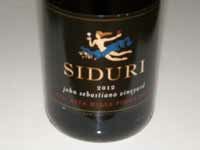 2012 Siduri John Sebastiano Vineyard Sta. Rita Hills Pinot Noir 14.3% alc., 352 cases, $48. Released April 2014. · Moderately dark reddish purple color in the glass. Enticing aromas of blackberry jam, sassafras, vanilla and earthy flora. Delicious array of dark cherry and berry fruits supported by suave tannins. Very charming soft mouth feel with plenty of finishing grace. A very appealing, beautifully composed and seamless wine that will only get better in the cellar. A real standout. Score: 94
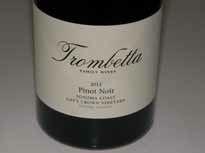 2011 Trombetta Family Wines Gap’s Crown Vineyard Sonoma Coast Pinot Noir 14.2% alc., 530 cases, $58. Clones are Swan, 777 and “828” planted between 2002 and 2005. Yield 2.3 tons per acre. Harvest Brix 25º. Fermented with native yeast, extended cold soak and maceration, native MLF in barrel, aged 9 months in 50% new French oak barrels. Unfined and unfiltered. · Moderately dark reddish purple color in the glass. Aromas of black cherry, blackberry and toasty oak are slow to arrive on the nose, but when they do, the experience draws you into the glass. Mid to full-bodied essence of dark Bing cherries with cola and oak in the background and a touch of citrus on the finish. A cohesive wine with plenty of sappy fruit balanced by integrated tannins. I liked the wine more as it unfolded in the glass over time. Very similar in character to a moderately bold Russian River Valley Pinot Noir. Runner up at recent Pigs and Pinot Sommelier Smackdown in Healdsburg. Score: 90
2011 Waterstone Carneros Pinot Noir 13.7% alc., pH 3.78, TA 0.56, 868 cases, $22. Sourced from Diamond Vineyard and Truchard Vineyard. 100% de-stemmed, whole berry fermented in open top fermenters, aged 16 months in 35% new and 65% used French oak barrels. Minimal fining and filtration before bottling. · Moderate reddish purple color in the glass. Aromas of cherry, plum and nutty-tobacco infused oak. Mid to full bodied core of earthy dark cherry, raspberry and plum fruits with modest tannins and a short finish. Good without being special. Score: 85
2012 Windy Oaks Terra Narro Schultze Family Vineyard Santa Cruz Mountains Pinot Noir 13.5% alc., $29. Unfined and unfiltered. · Moderately light reddish purple color in the glass. Expressive aromas of black cherry, rose petal, cedar and sandalwood hold up nicely over time in the glass. Moderately light on the palate with pleasing flavors of red cherry and supportive oak. A forward-drinking, friendly wine with juicy acidity. Score: 89
2012 Windy Oaks Estate Cuvée Schultze Family Vineyard Santa Cruz Mountains Pinot Noir 13.9% alc., $39. A mix of 5 clones from the estate home vineyard. Unfined and unfiltered. · Moderately light reddish purple color in the glass. Very floral initially, becoming more fruity over time. Intoxicating aromas of spice-infused cherries, roses, herbs, and subtle oak. Delicious essence of fresh cherries with an amalgam of accents including spice, cola, graham and anise. Modest in weight and very polished, with balanced tannins and a lengthy finish filled with cherry goodness. Score: 92
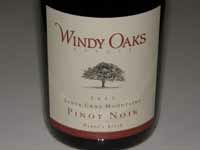 2012 Windy Oaks Estate Diane’s Block Klein Family Mountain Vineyard Santa Cruz Mountains Pinot Noir 13.9% alc., $45. Grown on a 5-acre slightly warmer site at a lower elevation than the Schultze Family Vineyard. The vineyard is located in an old apple orchard perched 600 feet above Monterey Bay adjacent Schultze Family Vineyard. · Modest reddish purple color in the glass. Plenty to discover in the nose which offers aromas of black cherry, black raspberry, spice, cola and leather glove. Welcome fullness and roundness to the sweet cherry-driven core of fruit complimented by subtle oak highlights. Impeccable balance and easy accessibility with a pleasingly silken finish. Score: 93
Pinot BriefsTalk of Grand Cru Vineyards in Oregon Katherine Cole recently posted on wine-searcher.com an article titled, “Oregon’s Five Grand Cru Sites of the Future.” Because of the interest of Burgundians in Oregon’s Willamette Valley, she makes a case for the Willamette Valley being the New World equivalent of Burgundy and a natural consideration is which sites are possibly of grand cru level. Her five choices include Abbey Ridge Vineyard, The Eyrie Vineyard, Jessie Vineyard (Cristom), Maresh Red Hills Vineyard, and Thomas Vineyard. She does admit leaving out many other possibilities, including 24 others, but curiously fails to mention Shea Vineyard. For now talk of a vineyard classification in Oregon is just that, talk. Carneros Wine Alliance Has a New Marketing Focus Carneros has been left behind of recent in promoting the region’s outstanding wines. A recent successful 2014 Annual Barrel Tasting Event on March 25 at ZD Wines barn confirm the new commitment to raise the level of awareness of the excellence of particularly Carneros Pinot Noir and Chardonnay. New leadership of the Carneros Wine Alliance, which includes T,J, Evans of Domaine Carneros, Anne Moller-Racke of The Donum Estate/Stemmler Winery, Brandon deLeuze of ZD Wines and Alison Crowe of Garnet Vineyards, among its 25 members, want Carneros in the conversation when California’s top regions for Pinot Noir and Chardonnay are discussed.
 Foley Family Wines Buys The Four Graces Foley Family Wines has acquired The Four Graces, a producer of premium Pinot Noir, Pinot Gris, Pinot Blanc located in the Dundee Hills of the Willamette Valley. The purchase includes the tasting room and the 540acre Black Family Estate Vineyard in the Dundee Hills, and the 41-acre Doe Ridge Estate Vineyard in the Yamhill-Carlton AVA. Foley owns more than 15 wine estates in the United States and New Zealand, but this is his first foray into Oregon. Ste. Michelle Acquires Eola-Amity Hills Property Ste. Michelle Wines has bought 298 acres formerly owned by CalPERS in the Eola-Amity Hills AVA, including the 119-acre Willakia Vineyard. Ste. Michelle plans to incorporate the Pinot Noir and Chardonnay from this vineyard into their Erath label which they acquired in 2006. Along with Atlas Vineyard Management’s recent acquisition of 683 acres including Cooper Creek and Fern Creek in the Willamette Valley, about 4,200 acres of vineyard land has changed hands in Oregon and Washington in the last year. Nike Cork Trainers This is the latest fashion accessory for winemakers and winery owners. Nike has released a line of training shoes as part of the NIKEiD Air Force 1 series that buyers can customize with the limited-edition cork upper or go all over, or complement the cork with premium leather accents. The trainers can be made with light or dark cork along with a number of other customizing features. Prices range from $190-$200. The cork option is only available for a limited time for men and women in both the high and low top design. Visit www.nike.com, if you are a wine geek. Pop Chart Lab Offers Napa & Sonoma Wine Maps The infographic company, Pop Chart Lab offers two maps for navigating the wineries of Napa and Sonoma, spotlighting over 500 wineries and vineyards in Sonoma and over 700 in Napa. Zoomed-out pockets help identify exact locations of wineries in densely populated areas. The California Wine Country Set is offered in 18” x 24” poster format in framed or unframed options ($54). A decorative addition to the den at home, but not helpful when you are on the road in these regions. Visit www.popchartlab.com. James Ontiveros & Matt Turrentine Buy Large Santa Maria Valley Acreage Lewis Purdue reported in Wine Industry Insight what was confirmed by Michael Fritz of Farmland Letter that Ontiveros and Turrentine (Grapevine Capital Parnters, a San Luis Obispo venture launched in 2012)) along with Harvard University’s endowment fund, acquired a 7,623-acre cattle ranch for $10,080,000 in northeast Santa Barbara County. The specific funding details are available to subscribers of Wine Executive News. Harvard has farm land holdings throughout the world, including a Dairy Farms Partnership in Central Otago, New Zealand. James recently told me that the region had sufficient underground water aquifers to be successfully farmed despite recent climate changes and drought conditions. Hanzell Vineyards President Takes New Role In June 2014, Jean Arnold Sessions will transition from her role as President of Hanzell Vineyards to Board Director and Brand Consultant. Jean Arnold Sessions has been with Hanzell Vineyrds since 1999, and was appointed President in 2002, taking over for Bob Sessions, now Winemaker Emeritus. Brooks Builds New Winery Construction has begun on a new 12,000-square-foot winery and tasting room on the Brooks Estate property, adjacent the winery’s estate vineyard and close to the current facility. Completion is expected by harvest 2014. The project was put into action by Managing Director Janie Brooks Heuck and Winemaker Chris Williams. The new grounds will feature gardens where they will grow biodynamic preparations for the estate vineyard. Founded in 1998, Brooks is a winery and biodynaically-farmed vineyard that continues to reflect the vision of Portland native Jimi Brooks. Third Generation Bacigalupis Recognized Katey Bacigalupi and Nicole Bacigalupi Derrico, granddaughters of Charles and Helen Bacigalupi, have been selected from dozens of nominations from Marin and Sonoma counties to the 8th Annual List of “Forty under 40,” announced recently by the North Bay Business Journal. With collective sales, marketing and agri-business degrees, the Bacigalupi twins are day to day managers of the winery and vineyard operation started half a century ago by their grandparents, Helen and Charles Bacigalupi. New Pinot Project at Alban Vineyards John Alban has had a fanatical pursuit of Rhone varietals. A 4.5-acre block of estate vineyard was planted in 1997 to Pinot Noir and Chardonnay. Located on a steep north facing hillside, it is known as North Vineyard. As the grapes have matured, the potential of the site became evident. In the 2012 vintage, Alban Vineyards is offering a North Chardonnay and North Pinot Noir to its mailing list for the first time. China Loves High Priced Wines According the www.thedrinksbusiness.com (April 14, 2014), China is now second to the United States as a buyer of high-priced wines. The Chinese, including buyers in Hong Kong, splurged 430% more on expensive wine between the years 2008 to 2012. China is now the world’s biggest consumer of red wine, overtaking France last year. Over 90% of the wine consumed in China is red, presumably because of the perceived health benefits. New Books on Burgundy There are three new books on Burgundy that are all worth your interest. The Climats of Burgundy: A Unique Millennia-old Heritage (Bernard Pivot, et al.), Histoire des Hospices de Beaune: vines, domaines et donateurs (Marie Thérèse Berthier & John-Thomas Sweeney, $75), and My Favorite Burgundies (Clive Coates MW, $60). New Wine Book from Alder Yarrow Yarrow collaborated with photographer Leigh Beisch to post an ongoing photo essay on aromatic and flavor components of wines in his blog, Vinography. The series of essays have been collected into a book, The Essence of Wine. Can be pre-ordered at www.vinography.com (hardcover is $70 and eBook is #35.)
Alquimie: “The Drinks Are On Us”
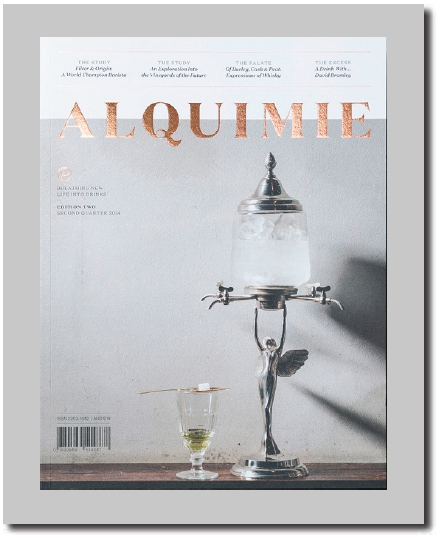 The Brits and Aussies take their wine very seriously and each country now has a distinguished publication directed at the aesthetics of wine. The World of Fine Wine, published in the UK and the pioneer in this wine publication genre, has now been joined by Alquimie, an Australian offering published four times a year under the direction of Editor-In-Chief Joshua Elias. Edition Two was released in the second quarter of 2014. Alquimie is both educational and philosophical, enticingly readable, beautifully photographed, and professionally composed. Unlike The World of Fine Wine, Alquimie has a more expanded horizon of imbibeworthy subject matter. The current issue covers microbrews, spirits, and even coffee, water (“When the Clouds Touch the Ground”) and milk (“What Ever Happened to Real Milk”), as well as French truffles ( a gorgeously photographed coverage at Cioccolato Lombardo in Prahran, Australia). It is the superb wine articles that are the heart and soul of the magazine and the most important reason to subscribe. The current issue covers Chianti (“Classico No More?), Portuguese grape varieties (“Um Cacho de Uvas), South African Chenin Blanc, the Australian Vineyards of the Future program, the 2008 Second Growth Bordeaux wines (“In Search of Claret”), and Pereira D’Oliveira Madeira (“100 Years Between Drinks”). The current edition of 172 pages is almost completely devoid of advertising. In essence, the magazine is a book in disguise and worthy of keeping on your shelf for reference. Alquimie’s Manifesto is of great interest and reflects the thoughtfulness and intent of this journal. The four tenants are as follows: (1) Perception goes far beyond desirable taste, (2) The context in which we drink is as important as what we drink, (3) The creation of drink informs our understanding of it, and (4) To understand the value of alcohol, we must first appreciate each other. To expand the fourth tenant, the authors say, “It is our responsibility to drink with a conscience. A conscience that respects the quality of what we drink and when we drink it. It is how we drink....it is why we drink. It is how we choose to live.” Subscriptions are $100 for four editions including worldwide postage and handling. Visit www.alquimie.com.au.
Harvest Down UnderI want to leave you with a magnificent photograph of a Pinot Noir vineyard just before harvest owned and farmed by my good friend David Lloyd at Eldridge Estate Vineyard in Victoria, Mornington Peninsula, Australia.
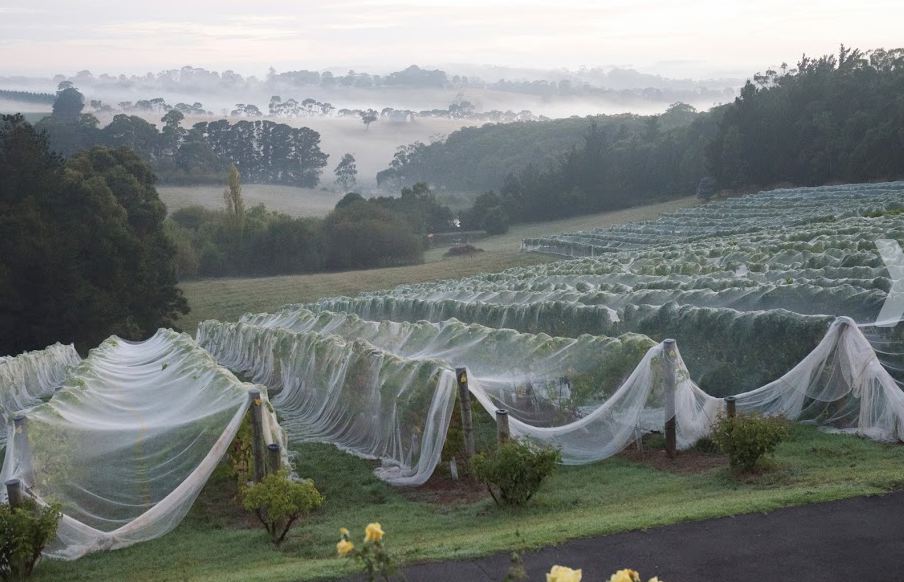 |